Entrepreneurship, Innovation and Management
VerifiedAdded on 2022/01/19
|20
|4188
|491
AI Summary
Contribute Materials
Your contribution can guide someone’s learning journey. Share your
documents today.
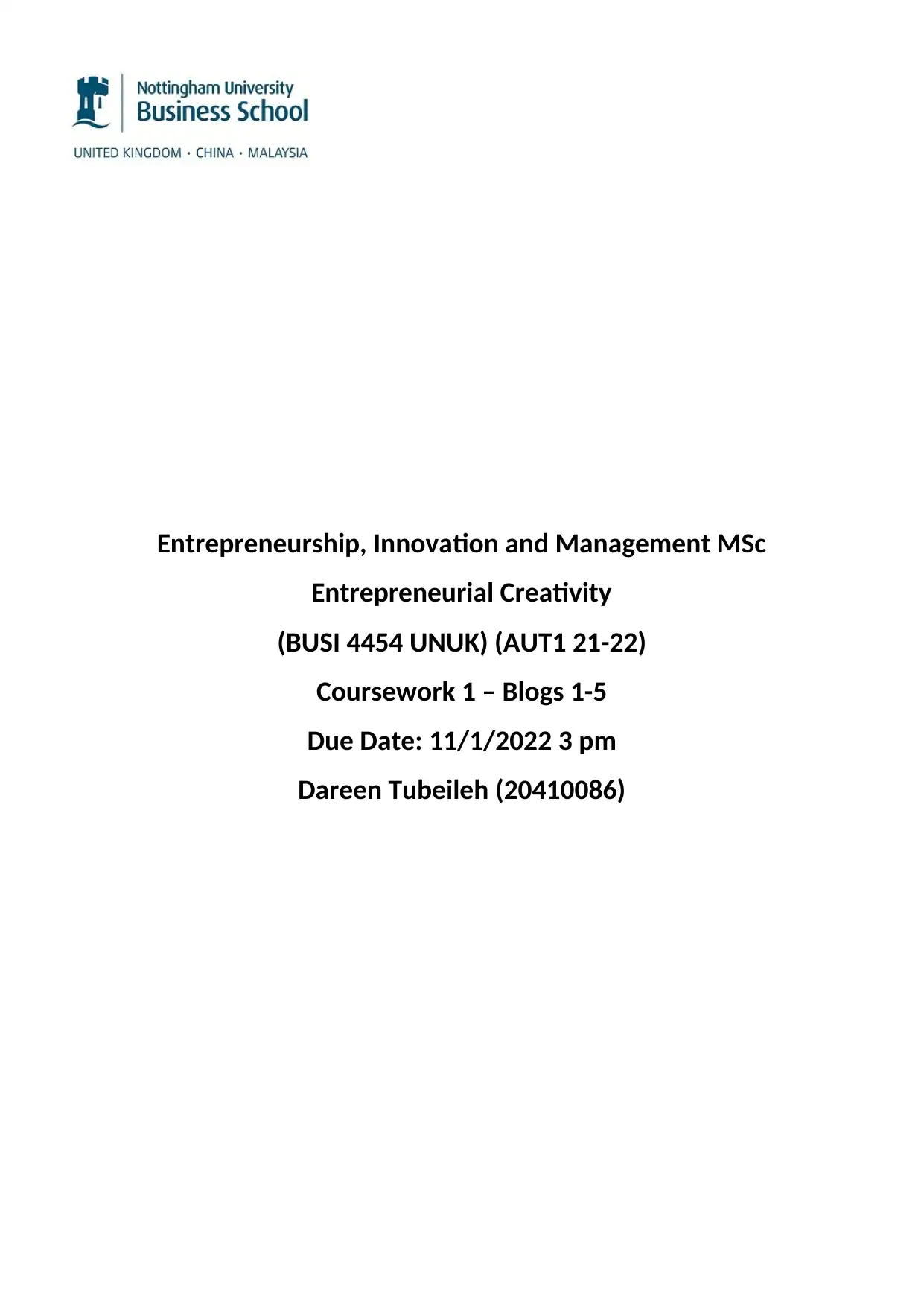
Entrepreneurship, Innovation and Management MSc
Entrepreneurial Creativity
(BUSI 4454 UNUK) (AUT1 21-22)
Coursework 1 – Blogs 1-5
Due Date: 11/1/2022 3 pm
Dareen Tubeileh (20410086)
Entrepreneurial Creativity
(BUSI 4454 UNUK) (AUT1 21-22)
Coursework 1 – Blogs 1-5
Due Date: 11/1/2022 3 pm
Dareen Tubeileh (20410086)
Secure Best Marks with AI Grader
Need help grading? Try our AI Grader for instant feedback on your assignments.
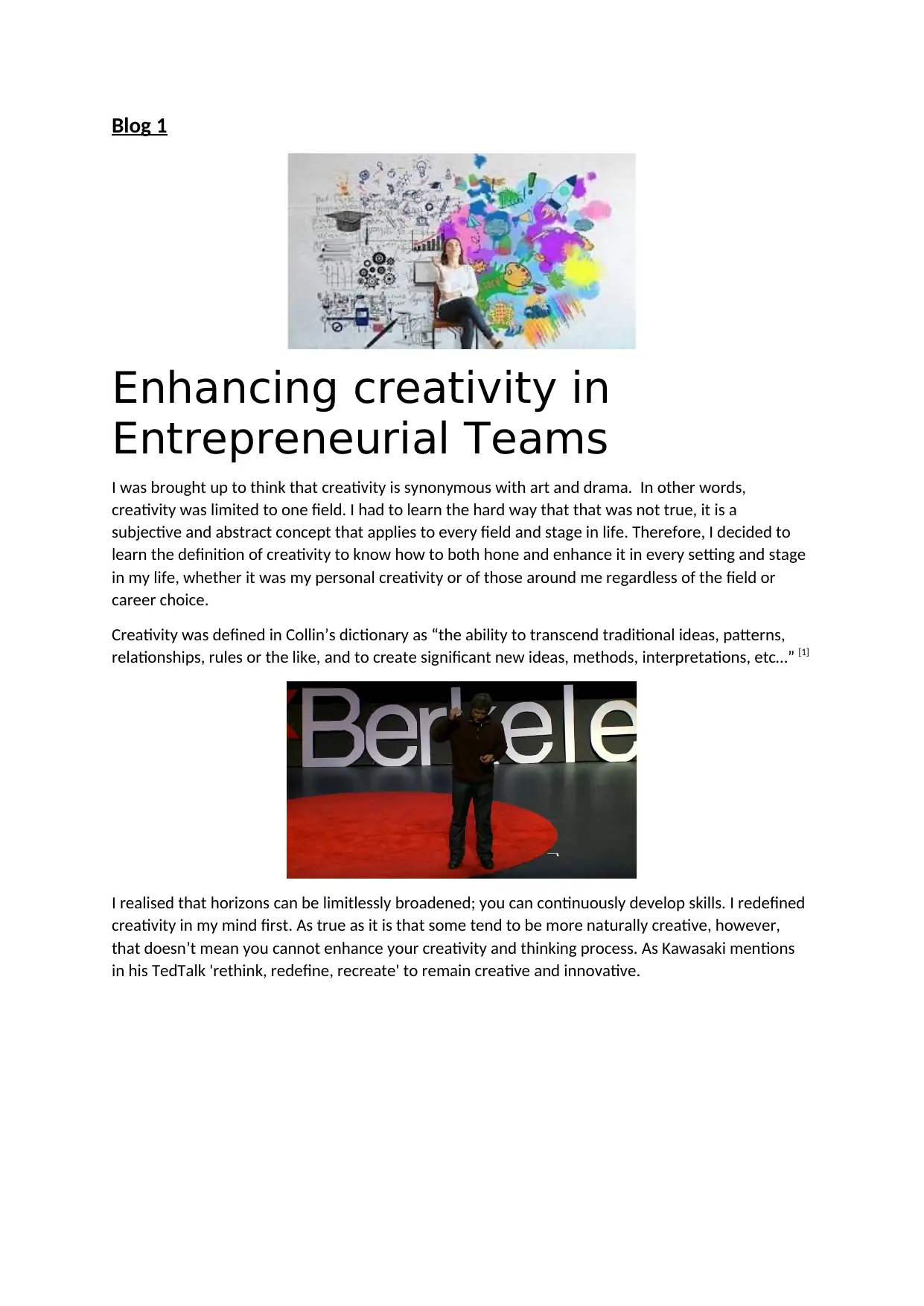
Blog 1
Enhancing creativity in
Entrepreneurial Teams
I was brought up to think that creativity is synonymous with art and drama. In other words,
creativity was limited to one field. I had to learn the hard way that that was not true, it is a
subjective and abstract concept that applies to every field and stage in life. Therefore, I decided to
learn the definition of creativity to know how to both hone and enhance it in every setting and stage
in my life, whether it was my personal creativity or of those around me regardless of the field or
career choice.
Creativity was defined in Collin’s dictionary as “the ability to transcend traditional ideas, patterns,
relationships, rules or the like, and to create significant new ideas, methods, interpretations, etc…” [1]
I realised that horizons can be limitlessly broadened; you can continuously develop skills. I redefined
creativity in my mind first. As true as it is that some tend to be more naturally creative, however,
that doesn’t mean you cannot enhance your creativity and thinking process. As Kawasaki mentions
in his TedTalk 'rethink, redefine, recreate' to remain creative and innovative.
Enhancing creativity in
Entrepreneurial Teams
I was brought up to think that creativity is synonymous with art and drama. In other words,
creativity was limited to one field. I had to learn the hard way that that was not true, it is a
subjective and abstract concept that applies to every field and stage in life. Therefore, I decided to
learn the definition of creativity to know how to both hone and enhance it in every setting and stage
in my life, whether it was my personal creativity or of those around me regardless of the field or
career choice.
Creativity was defined in Collin’s dictionary as “the ability to transcend traditional ideas, patterns,
relationships, rules or the like, and to create significant new ideas, methods, interpretations, etc…” [1]
I realised that horizons can be limitlessly broadened; you can continuously develop skills. I redefined
creativity in my mind first. As true as it is that some tend to be more naturally creative, however,
that doesn’t mean you cannot enhance your creativity and thinking process. As Kawasaki mentions
in his TedTalk 'rethink, redefine, recreate' to remain creative and innovative.
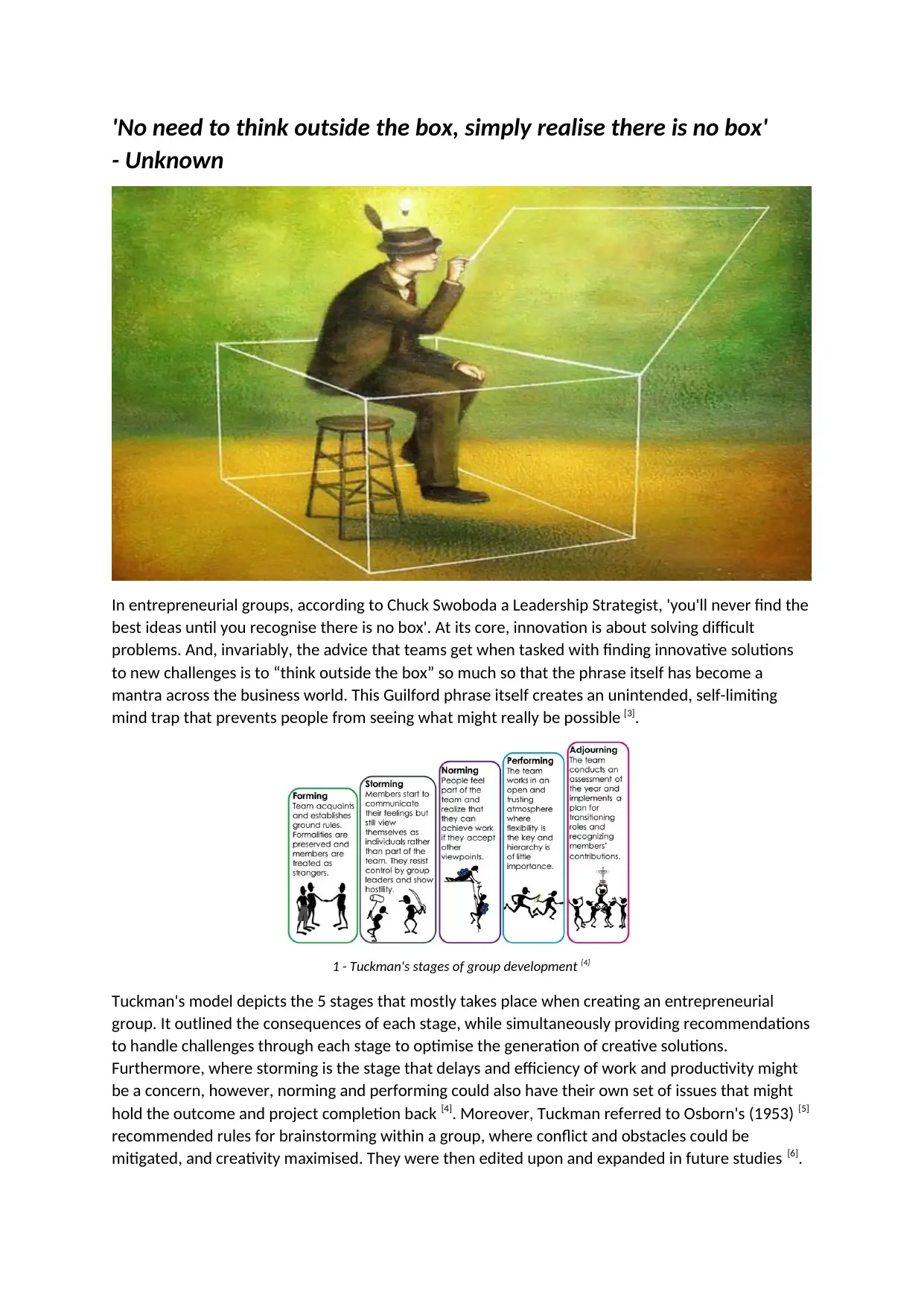
'No need to think outside the box, simply realise there is no box'
- Unknown
In entrepreneurial groups, according to Chuck Swoboda a Leadership Strategist, 'you'll never find the
best ideas until you recognise there is no box'. At its core, innovation is about solving difficult
problems. And, invariably, the advice that teams get when tasked with finding innovative solutions
to new challenges is to “think outside the box” so much so that the phrase itself has become a
mantra across the business world. This Guilford phrase itself creates an unintended, self-limiting
mind trap that prevents people from seeing what might really be possible [3].
1 - Tuckman's stages of group development [4]
Tuckman's model depicts the 5 stages that mostly takes place when creating an entrepreneurial
group. It outlined the consequences of each stage, while simultaneously providing recommendations
to handle challenges through each stage to optimise the generation of creative solutions.
Furthermore, where storming is the stage that delays and efficiency of work and productivity might
be a concern, however, norming and performing could also have their own set of issues that might
hold the outcome and project completion back [4]. Moreover, Tuckman referred to Osborn's (1953) [5]
recommended rules for brainstorming within a group, where conflict and obstacles could be
mitigated, and creativity maximised. They were then edited upon and expanded in future studies [6].
- Unknown
In entrepreneurial groups, according to Chuck Swoboda a Leadership Strategist, 'you'll never find the
best ideas until you recognise there is no box'. At its core, innovation is about solving difficult
problems. And, invariably, the advice that teams get when tasked with finding innovative solutions
to new challenges is to “think outside the box” so much so that the phrase itself has become a
mantra across the business world. This Guilford phrase itself creates an unintended, self-limiting
mind trap that prevents people from seeing what might really be possible [3].
1 - Tuckman's stages of group development [4]
Tuckman's model depicts the 5 stages that mostly takes place when creating an entrepreneurial
group. It outlined the consequences of each stage, while simultaneously providing recommendations
to handle challenges through each stage to optimise the generation of creative solutions.
Furthermore, where storming is the stage that delays and efficiency of work and productivity might
be a concern, however, norming and performing could also have their own set of issues that might
hold the outcome and project completion back [4]. Moreover, Tuckman referred to Osborn's (1953) [5]
recommended rules for brainstorming within a group, where conflict and obstacles could be
mitigated, and creativity maximised. They were then edited upon and expanded in future studies [6].
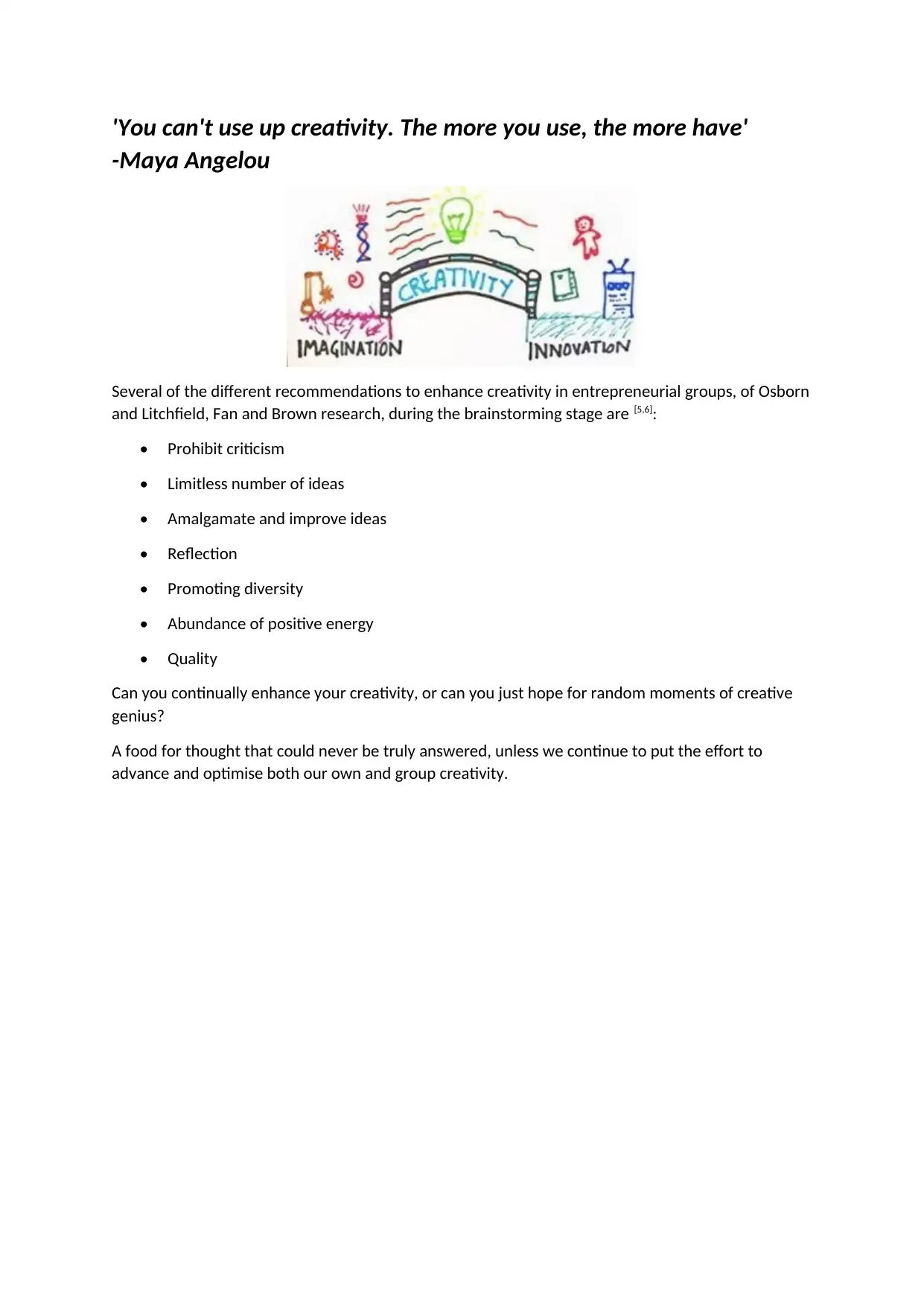
'You can't use up creativity. The more you use, the more have'
-Maya Angelou
Several of the different recommendations to enhance creativity in entrepreneurial groups, of Osborn
and Litchfield, Fan and Brown research, during the brainstorming stage are [5,6]:
• Prohibit criticism
• Limitless number of ideas
• Amalgamate and improve ideas
• Reflection
• Promoting diversity
• Abundance of positive energy
• Quality
Can you continually enhance your creativity, or can you just hope for random moments of creative
genius?
A food for thought that could never be truly answered, unless we continue to put the effort to
advance and optimise both our own and group creativity.
-Maya Angelou
Several of the different recommendations to enhance creativity in entrepreneurial groups, of Osborn
and Litchfield, Fan and Brown research, during the brainstorming stage are [5,6]:
• Prohibit criticism
• Limitless number of ideas
• Amalgamate and improve ideas
• Reflection
• Promoting diversity
• Abundance of positive energy
• Quality
Can you continually enhance your creativity, or can you just hope for random moments of creative
genius?
A food for thought that could never be truly answered, unless we continue to put the effort to
advance and optimise both our own and group creativity.
Secure Best Marks with AI Grader
Need help grading? Try our AI Grader for instant feedback on your assignments.
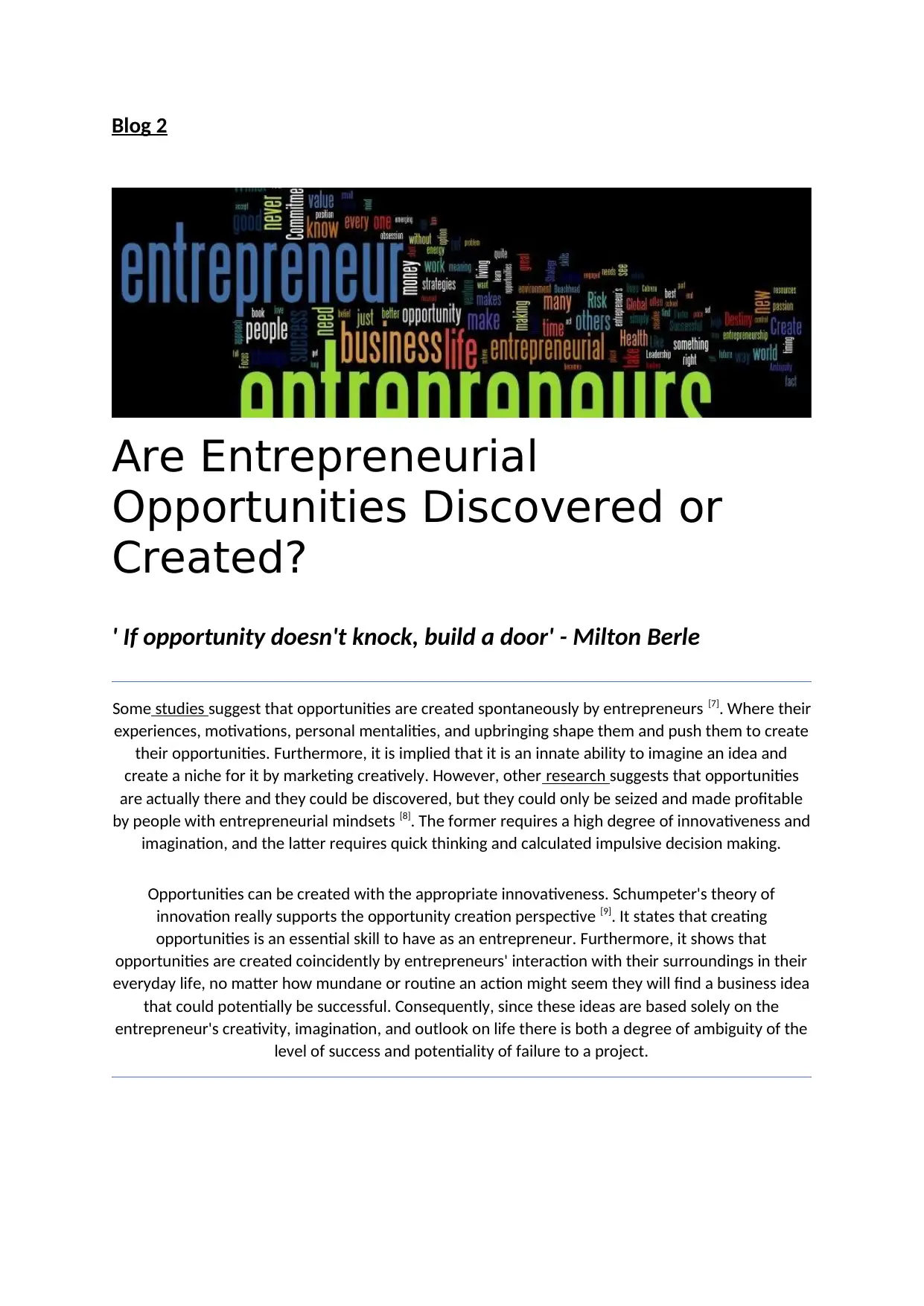
Blog 2
Are Entrepreneurial
Opportunities Discovered or
Created?
' If opportunity doesn't knock, build a door' - Milton Berle
Some studies suggest that opportunities are created spontaneously by entrepreneurs [7]. Where their
experiences, motivations, personal mentalities, and upbringing shape them and push them to create
their opportunities. Furthermore, it is implied that it is an innate ability to imagine an idea and
create a niche for it by marketing creatively. However, other research suggests that opportunities
are actually there and they could be discovered, but they could only be seized and made profitable
by people with entrepreneurial mindsets [8]. The former requires a high degree of innovativeness and
imagination, and the latter requires quick thinking and calculated impulsive decision making.
Opportunities can be created with the appropriate innovativeness. Schumpeter's theory of
innovation really supports the opportunity creation perspective [9]. It states that creating
opportunities is an essential skill to have as an entrepreneur. Furthermore, it shows that
opportunities are created coincidently by entrepreneurs' interaction with their surroundings in their
everyday life, no matter how mundane or routine an action might seem they will find a business idea
that could potentially be successful. Consequently, since these ideas are based solely on the
entrepreneur's creativity, imagination, and outlook on life there is both a degree of ambiguity of the
level of success and potentiality of failure to a project.
Are Entrepreneurial
Opportunities Discovered or
Created?
' If opportunity doesn't knock, build a door' - Milton Berle
Some studies suggest that opportunities are created spontaneously by entrepreneurs [7]. Where their
experiences, motivations, personal mentalities, and upbringing shape them and push them to create
their opportunities. Furthermore, it is implied that it is an innate ability to imagine an idea and
create a niche for it by marketing creatively. However, other research suggests that opportunities
are actually there and they could be discovered, but they could only be seized and made profitable
by people with entrepreneurial mindsets [8]. The former requires a high degree of innovativeness and
imagination, and the latter requires quick thinking and calculated impulsive decision making.
Opportunities can be created with the appropriate innovativeness. Schumpeter's theory of
innovation really supports the opportunity creation perspective [9]. It states that creating
opportunities is an essential skill to have as an entrepreneur. Furthermore, it shows that
opportunities are created coincidently by entrepreneurs' interaction with their surroundings in their
everyday life, no matter how mundane or routine an action might seem they will find a business idea
that could potentially be successful. Consequently, since these ideas are based solely on the
entrepreneur's creativity, imagination, and outlook on life there is both a degree of ambiguity of the
level of success and potentiality of failure to a project.
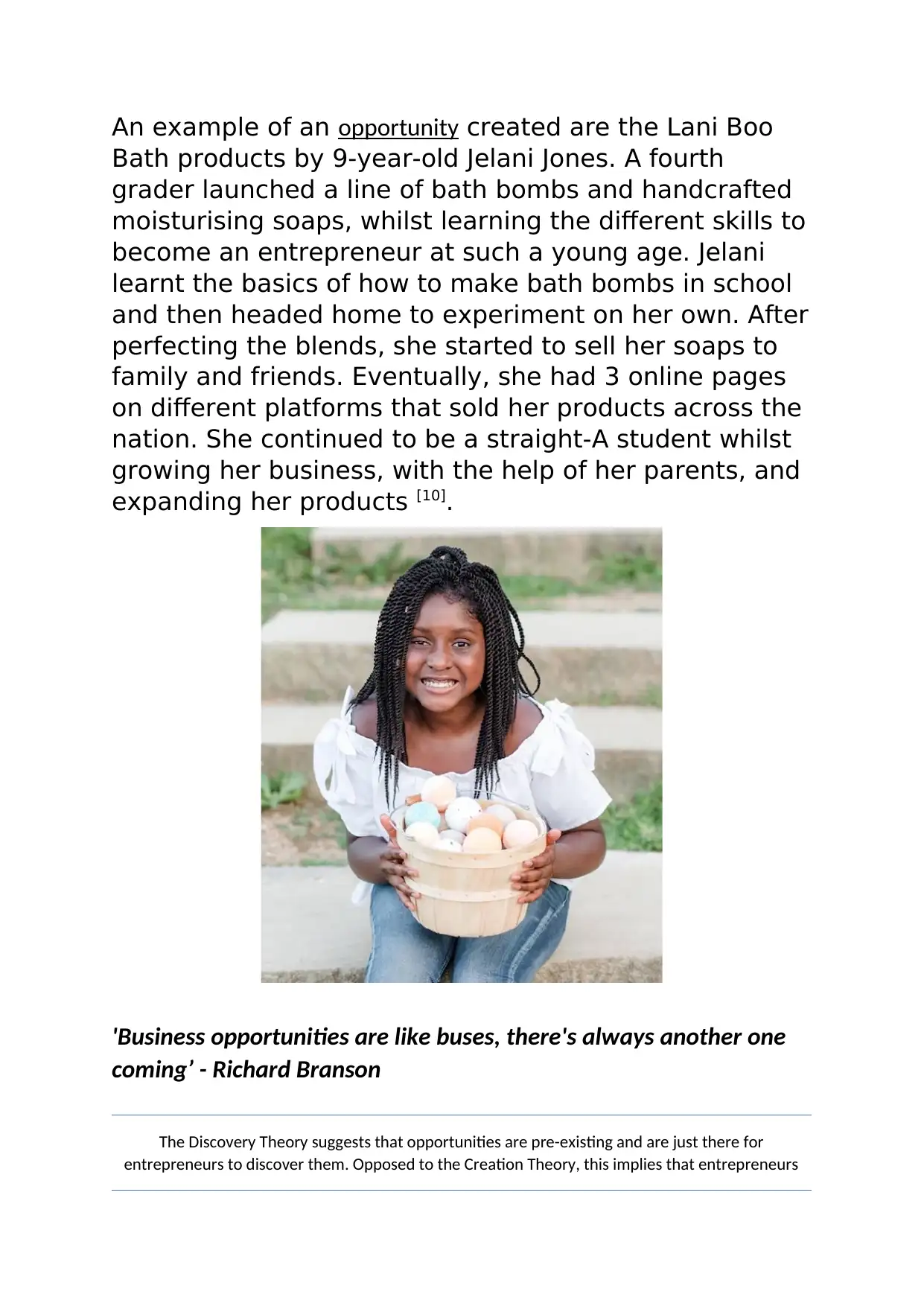
An example of an opportunity created are the Lani Boo
Bath products by 9-year-old Jelani Jones. A fourth
grader launched a line of bath bombs and handcrafted
moisturising soaps, whilst learning the different skills to
become an entrepreneur at such a young age. Jelani
learnt the basics of how to make bath bombs in school
and then headed home to experiment on her own. After
perfecting the blends, she started to sell her soaps to
family and friends. Eventually, she had 3 online pages
on different platforms that sold her products across the
nation. She continued to be a straight-A student whilst
growing her business, with the help of her parents, and
expanding her products [10].
'Business opportunities are like buses, there's always another one
coming’ - Richard Branson
The Discovery Theory suggests that opportunities are pre-existing and are just there for
entrepreneurs to discover them. Opposed to the Creation Theory, this implies that entrepreneurs
Bath products by 9-year-old Jelani Jones. A fourth
grader launched a line of bath bombs and handcrafted
moisturising soaps, whilst learning the different skills to
become an entrepreneur at such a young age. Jelani
learnt the basics of how to make bath bombs in school
and then headed home to experiment on her own. After
perfecting the blends, she started to sell her soaps to
family and friends. Eventually, she had 3 online pages
on different platforms that sold her products across the
nation. She continued to be a straight-A student whilst
growing her business, with the help of her parents, and
expanding her products [10].
'Business opportunities are like buses, there's always another one
coming’ - Richard Branson
The Discovery Theory suggests that opportunities are pre-existing and are just there for
entrepreneurs to discover them. Opposed to the Creation Theory, this implies that entrepreneurs
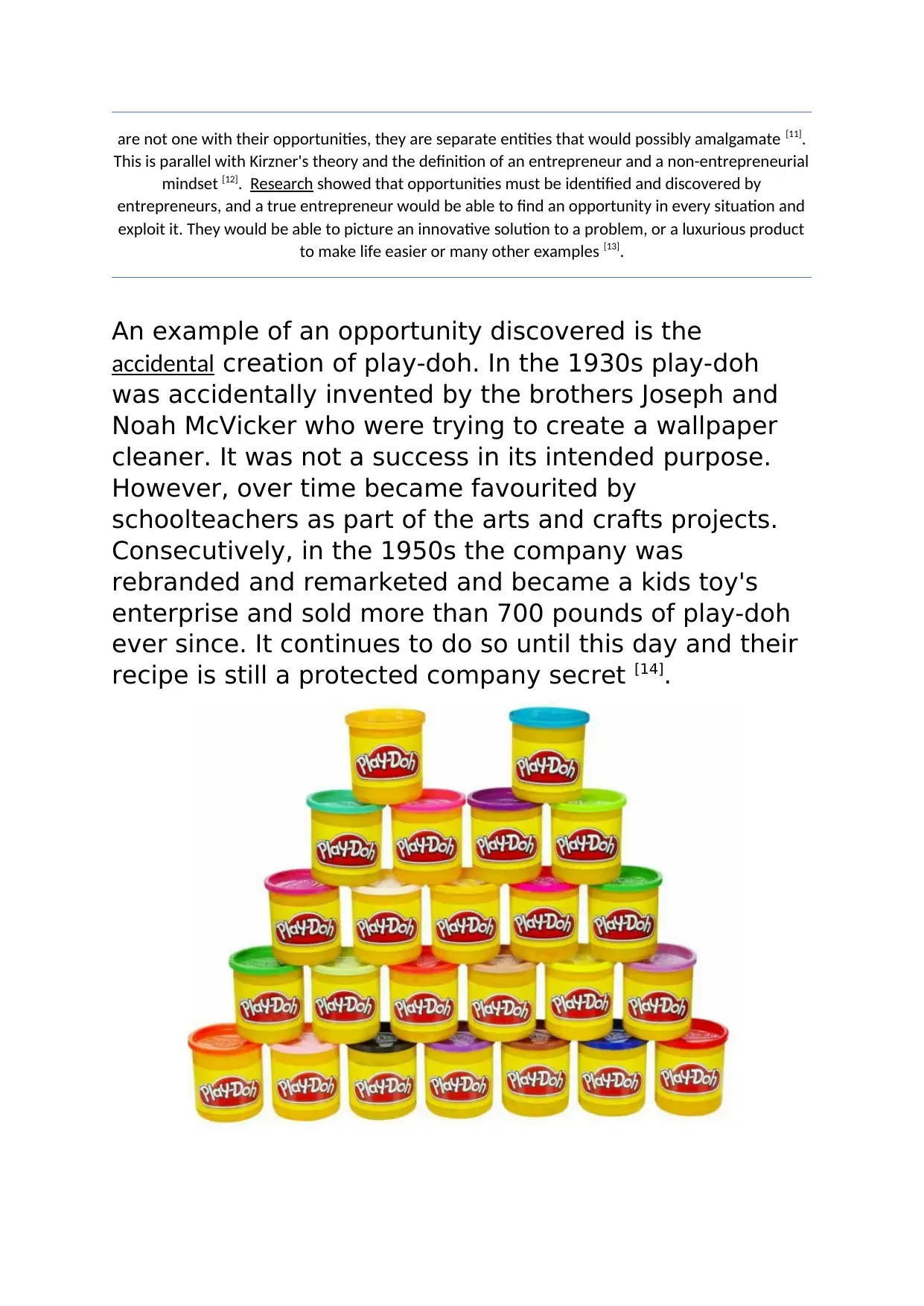
are not one with their opportunities, they are separate entities that would possibly amalgamate [11].
This is parallel with Kirzner's theory and the definition of an entrepreneur and a non-entrepreneurial
mindset [12]. Research showed that opportunities must be identified and discovered by
entrepreneurs, and a true entrepreneur would be able to find an opportunity in every situation and
exploit it. They would be able to picture an innovative solution to a problem, or a luxurious product
to make life easier or many other examples [13].
An example of an opportunity discovered is the
accidental creation of play-doh. In the 1930s play-doh
was accidentally invented by the brothers Joseph and
Noah McVicker who were trying to create a wallpaper
cleaner. It was not a success in its intended purpose.
However, over time became favourited by
schoolteachers as part of the arts and crafts projects.
Consecutively, in the 1950s the company was
rebranded and remarketed and became a kids toy's
enterprise and sold more than 700 pounds of play-doh
ever since. It continues to do so until this day and their
recipe is still a protected company secret [14].
This is parallel with Kirzner's theory and the definition of an entrepreneur and a non-entrepreneurial
mindset [12]. Research showed that opportunities must be identified and discovered by
entrepreneurs, and a true entrepreneur would be able to find an opportunity in every situation and
exploit it. They would be able to picture an innovative solution to a problem, or a luxurious product
to make life easier or many other examples [13].
An example of an opportunity discovered is the
accidental creation of play-doh. In the 1930s play-doh
was accidentally invented by the brothers Joseph and
Noah McVicker who were trying to create a wallpaper
cleaner. It was not a success in its intended purpose.
However, over time became favourited by
schoolteachers as part of the arts and crafts projects.
Consecutively, in the 1950s the company was
rebranded and remarketed and became a kids toy's
enterprise and sold more than 700 pounds of play-doh
ever since. It continues to do so until this day and their
recipe is still a protected company secret [14].
Paraphrase This Document
Need a fresh take? Get an instant paraphrase of this document with our AI Paraphraser
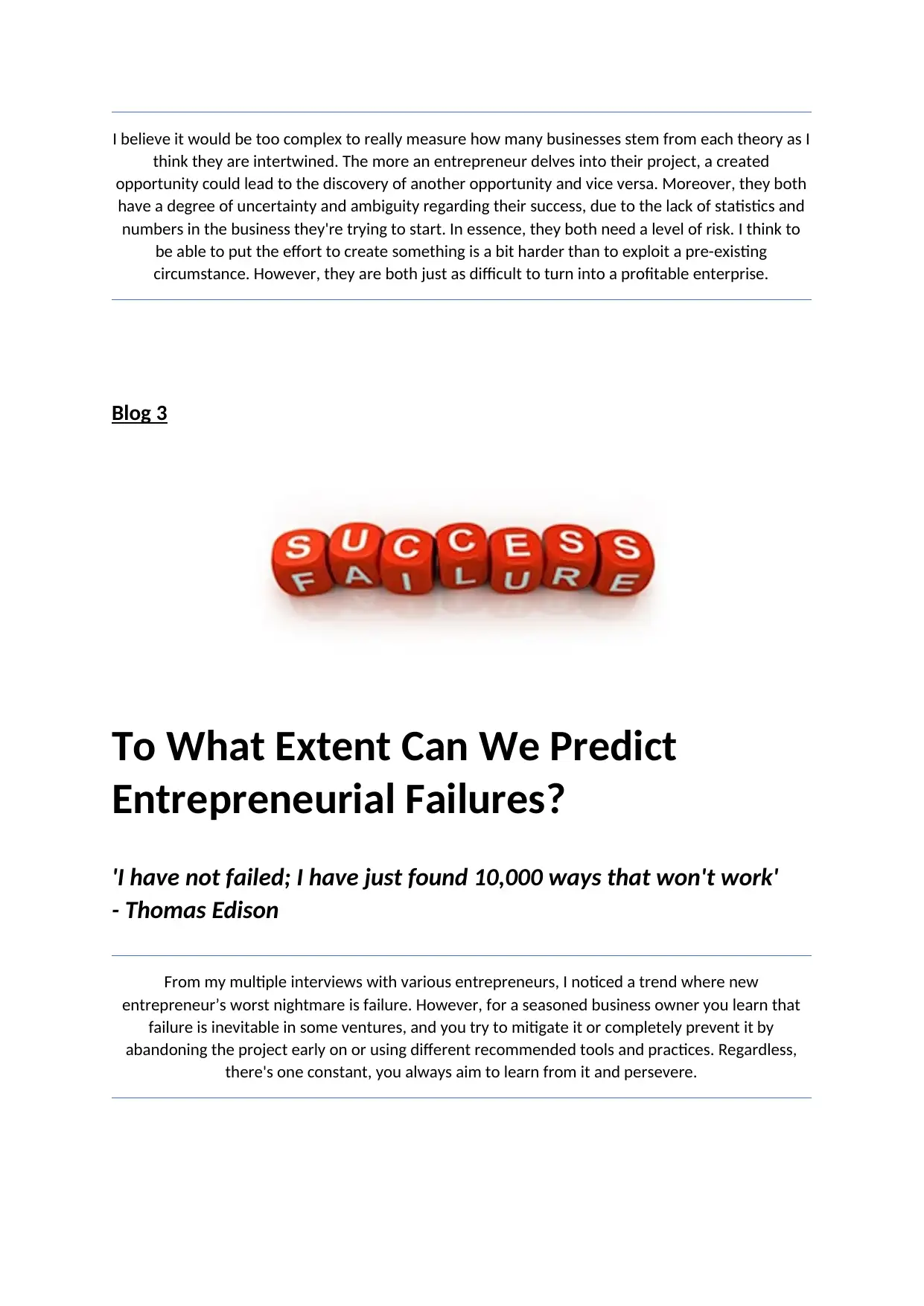
I believe it would be too complex to really measure how many businesses stem from each theory as I
think they are intertwined. The more an entrepreneur delves into their project, a created
opportunity could lead to the discovery of another opportunity and vice versa. Moreover, they both
have a degree of uncertainty and ambiguity regarding their success, due to the lack of statistics and
numbers in the business they're trying to start. In essence, they both need a level of risk. I think to
be able to put the effort to create something is a bit harder than to exploit a pre-existing
circumstance. However, they are both just as difficult to turn into a profitable enterprise.
Blog 3
To What Extent Can We Predict
Entrepreneurial Failures?
'I have not failed; I have just found 10,000 ways that won't work'
- Thomas Edison
From my multiple interviews with various entrepreneurs, I noticed a trend where new
entrepreneur’s worst nightmare is failure. However, for a seasoned business owner you learn that
failure is inevitable in some ventures, and you try to mitigate it or completely prevent it by
abandoning the project early on or using different recommended tools and practices. Regardless,
there's one constant, you always aim to learn from it and persevere.
think they are intertwined. The more an entrepreneur delves into their project, a created
opportunity could lead to the discovery of another opportunity and vice versa. Moreover, they both
have a degree of uncertainty and ambiguity regarding their success, due to the lack of statistics and
numbers in the business they're trying to start. In essence, they both need a level of risk. I think to
be able to put the effort to create something is a bit harder than to exploit a pre-existing
circumstance. However, they are both just as difficult to turn into a profitable enterprise.
Blog 3
To What Extent Can We Predict
Entrepreneurial Failures?
'I have not failed; I have just found 10,000 ways that won't work'
- Thomas Edison
From my multiple interviews with various entrepreneurs, I noticed a trend where new
entrepreneur’s worst nightmare is failure. However, for a seasoned business owner you learn that
failure is inevitable in some ventures, and you try to mitigate it or completely prevent it by
abandoning the project early on or using different recommended tools and practices. Regardless,
there's one constant, you always aim to learn from it and persevere.
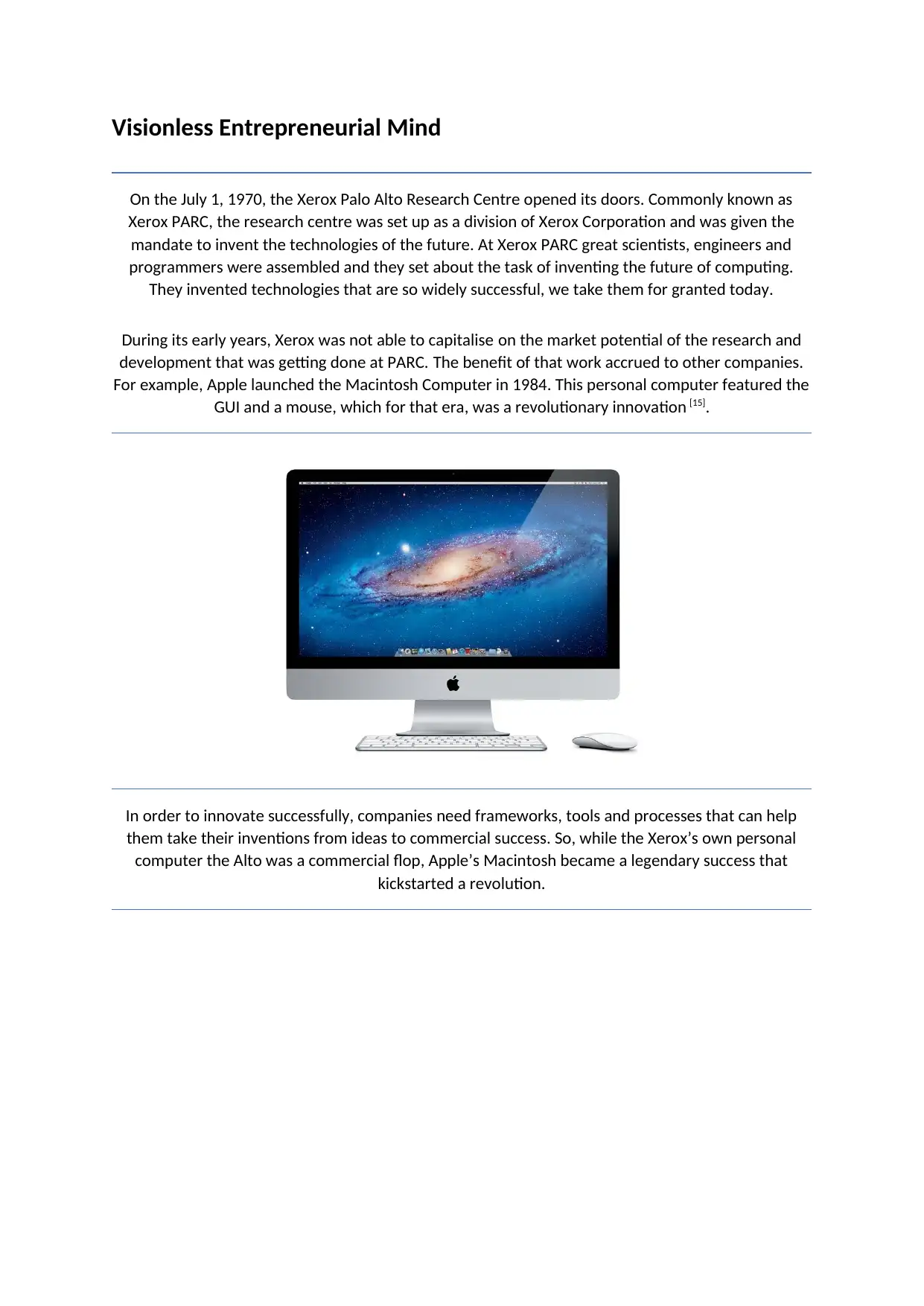
Visionless Entrepreneurial Mind
On the July 1, 1970, the Xerox Palo Alto Research Centre opened its doors. Commonly known as
Xerox PARC, the research centre was set up as a division of Xerox Corporation and was given the
mandate to invent the technologies of the future. At Xerox PARC great scientists, engineers and
programmers were assembled and they set about the task of inventing the future of computing.
They invented technologies that are so widely successful, we take them for granted today.
During its early years, Xerox was not able to capitalise on the market potential of the research and
development that was getting done at PARC. The benefit of that work accrued to other companies.
For example, Apple launched the Macintosh Computer in 1984. This personal computer featured the
GUI and a mouse, which for that era, was a revolutionary innovation [15].
In order to innovate successfully, companies need frameworks, tools and processes that can help
them take their inventions from ideas to commercial success. So, while the Xerox’s own personal
computer the Alto was a commercial flop, Apple’s Macintosh became a legendary success that
kickstarted a revolution.
On the July 1, 1970, the Xerox Palo Alto Research Centre opened its doors. Commonly known as
Xerox PARC, the research centre was set up as a division of Xerox Corporation and was given the
mandate to invent the technologies of the future. At Xerox PARC great scientists, engineers and
programmers were assembled and they set about the task of inventing the future of computing.
They invented technologies that are so widely successful, we take them for granted today.
During its early years, Xerox was not able to capitalise on the market potential of the research and
development that was getting done at PARC. The benefit of that work accrued to other companies.
For example, Apple launched the Macintosh Computer in 1984. This personal computer featured the
GUI and a mouse, which for that era, was a revolutionary innovation [15].
In order to innovate successfully, companies need frameworks, tools and processes that can help
them take their inventions from ideas to commercial success. So, while the Xerox’s own personal
computer the Alto was a commercial flop, Apple’s Macintosh became a legendary success that
kickstarted a revolution.
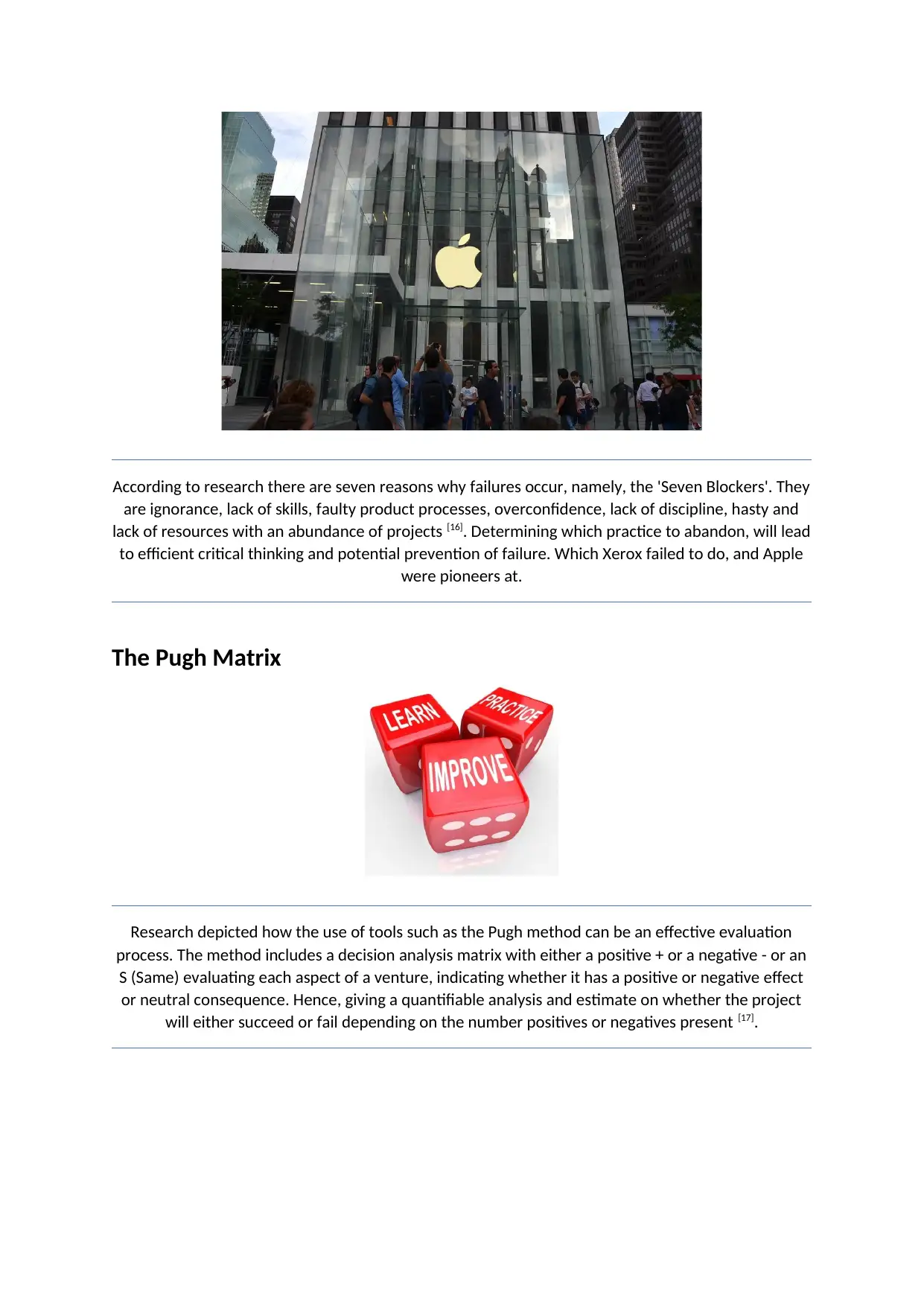
According to research there are seven reasons why failures occur, namely, the 'Seven Blockers'. They
are ignorance, lack of skills, faulty product processes, overconfidence, lack of discipline, hasty and
lack of resources with an abundance of projects [16]. Determining which practice to abandon, will lead
to efficient critical thinking and potential prevention of failure. Which Xerox failed to do, and Apple
were pioneers at.
The Pugh Matrix
Research depicted how the use of tools such as the Pugh method can be an effective evaluation
process. The method includes a decision analysis matrix with either a positive + or a negative - or an
S (Same) evaluating each aspect of a venture, indicating whether it has a positive or negative effect
or neutral consequence. Hence, giving a quantifiable analysis and estimate on whether the project
will either succeed or fail depending on the number positives or negatives present [17].
are ignorance, lack of skills, faulty product processes, overconfidence, lack of discipline, hasty and
lack of resources with an abundance of projects [16]. Determining which practice to abandon, will lead
to efficient critical thinking and potential prevention of failure. Which Xerox failed to do, and Apple
were pioneers at.
The Pugh Matrix
Research depicted how the use of tools such as the Pugh method can be an effective evaluation
process. The method includes a decision analysis matrix with either a positive + or a negative - or an
S (Same) evaluating each aspect of a venture, indicating whether it has a positive or negative effect
or neutral consequence. Hence, giving a quantifiable analysis and estimate on whether the project
will either succeed or fail depending on the number positives or negatives present [17].
Secure Best Marks with AI Grader
Need help grading? Try our AI Grader for instant feedback on your assignments.
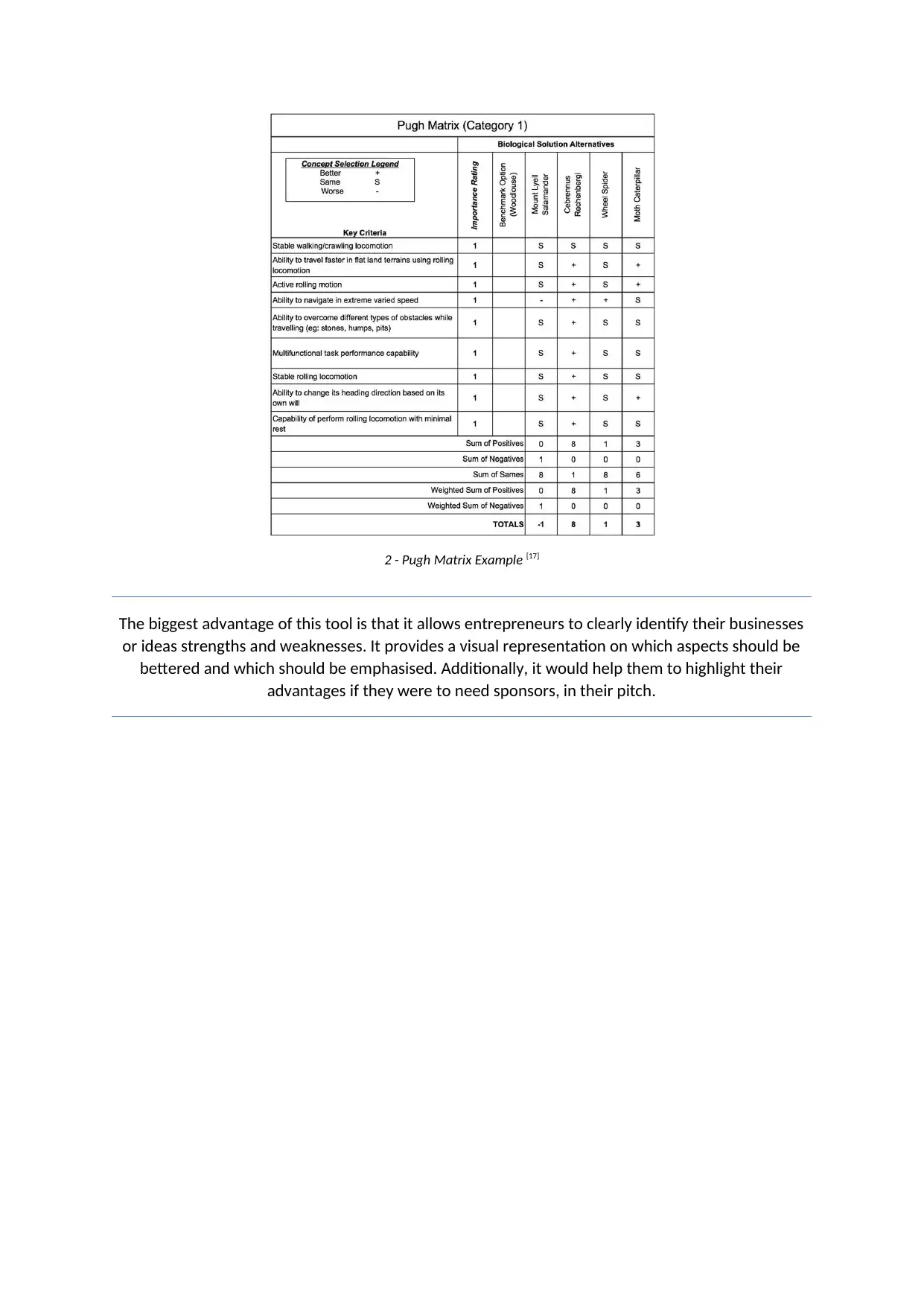
2 - Pugh Matrix Example [17]
The biggest advantage of this tool is that it allows entrepreneurs to clearly identify their businesses
or ideas strengths and weaknesses. It provides a visual representation on which aspects should be
bettered and which should be emphasised. Additionally, it would help them to highlight their
advantages if they were to need sponsors, in their pitch.
The biggest advantage of this tool is that it allows entrepreneurs to clearly identify their businesses
or ideas strengths and weaknesses. It provides a visual representation on which aspects should be
bettered and which should be emphasised. Additionally, it would help them to highlight their
advantages if they were to need sponsors, in their pitch.
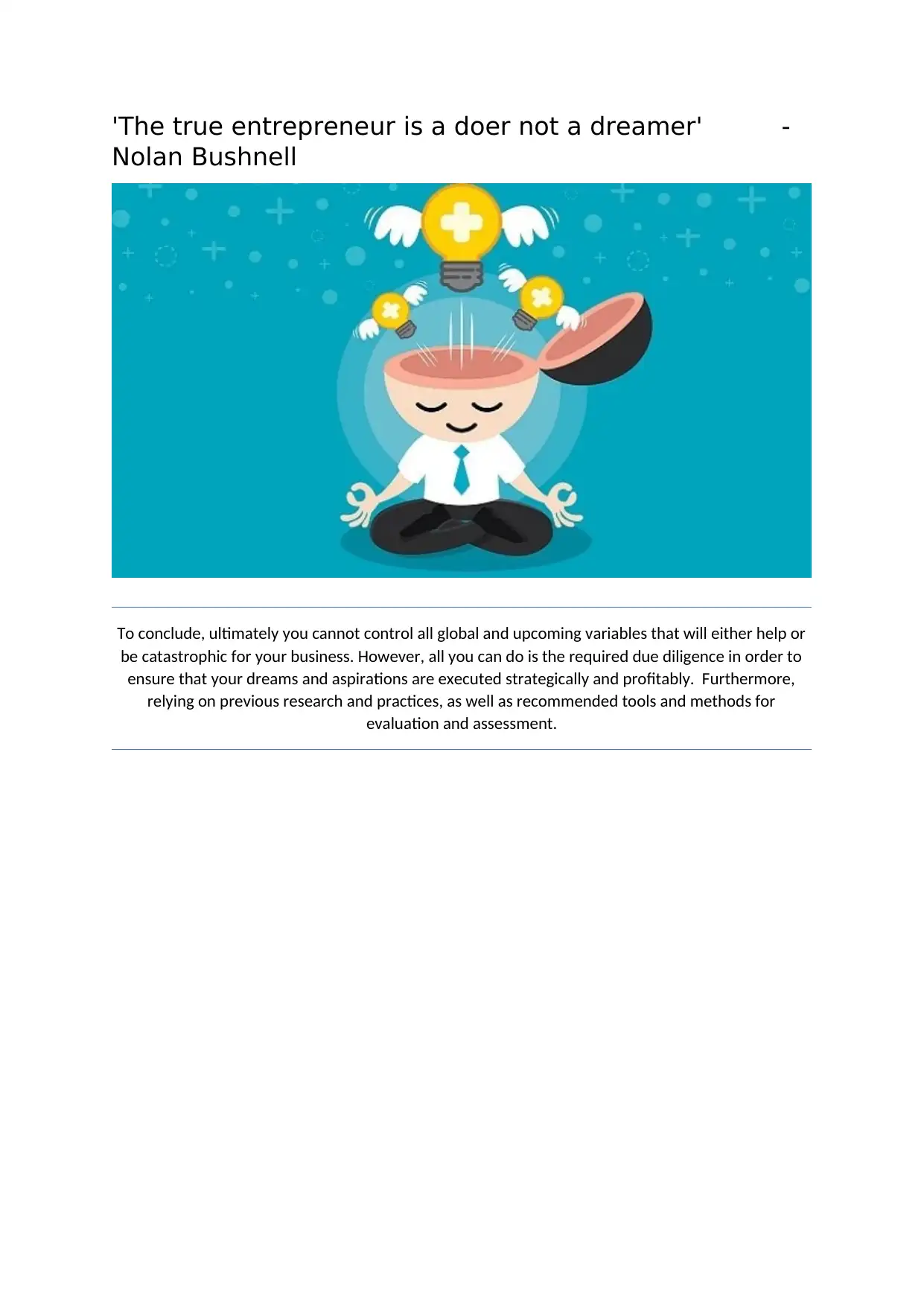
'The true entrepreneur is a doer not a dreamer' -
Nolan Bushnell
To conclude, ultimately you cannot control all global and upcoming variables that will either help or
be catastrophic for your business. However, all you can do is the required due diligence in order to
ensure that your dreams and aspirations are executed strategically and profitably. Furthermore,
relying on previous research and practices, as well as recommended tools and methods for
evaluation and assessment.
Nolan Bushnell
To conclude, ultimately you cannot control all global and upcoming variables that will either help or
be catastrophic for your business. However, all you can do is the required due diligence in order to
ensure that your dreams and aspirations are executed strategically and profitably. Furthermore,
relying on previous research and practices, as well as recommended tools and methods for
evaluation and assessment.
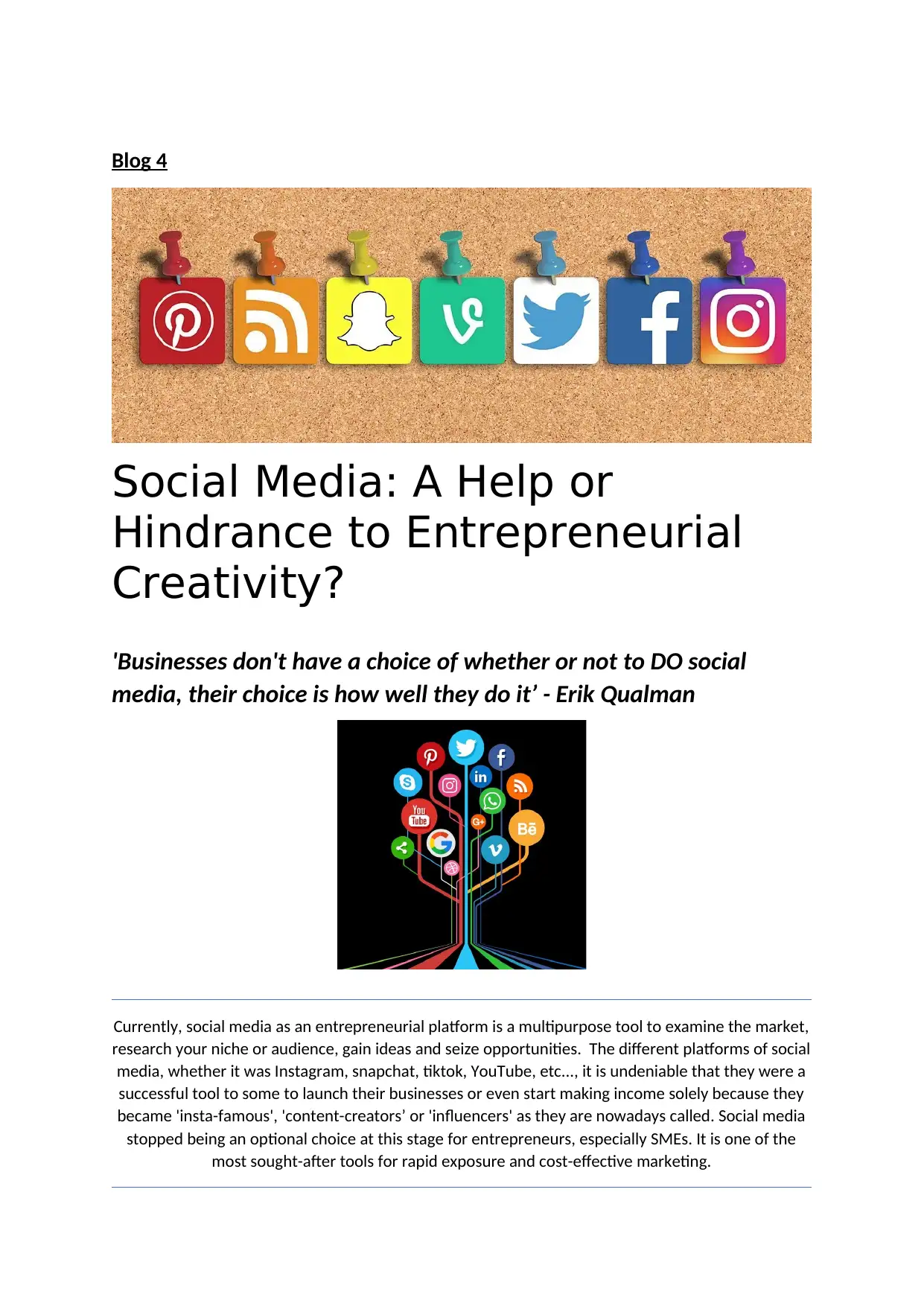
Blog 4
Social Media: A Help or
Hindrance to Entrepreneurial
Creativity?
'Businesses don't have a choice of whether or not to DO social
media, their choice is how well they do it’ - Erik Qualman
Currently, social media as an entrepreneurial platform is a multipurpose tool to examine the market,
research your niche or audience, gain ideas and seize opportunities. The different platforms of social
media, whether it was Instagram, snapchat, tiktok, YouTube, etc..., it is undeniable that they were a
successful tool to some to launch their businesses or even start making income solely because they
became 'insta-famous', 'content-creators’ or 'influencers' as they are nowadays called. Social media
stopped being an optional choice at this stage for entrepreneurs, especially SMEs. It is one of the
most sought-after tools for rapid exposure and cost-effective marketing.
Social Media: A Help or
Hindrance to Entrepreneurial
Creativity?
'Businesses don't have a choice of whether or not to DO social
media, their choice is how well they do it’ - Erik Qualman
Currently, social media as an entrepreneurial platform is a multipurpose tool to examine the market,
research your niche or audience, gain ideas and seize opportunities. The different platforms of social
media, whether it was Instagram, snapchat, tiktok, YouTube, etc..., it is undeniable that they were a
successful tool to some to launch their businesses or even start making income solely because they
became 'insta-famous', 'content-creators’ or 'influencers' as they are nowadays called. Social media
stopped being an optional choice at this stage for entrepreneurs, especially SMEs. It is one of the
most sought-after tools for rapid exposure and cost-effective marketing.
Paraphrase This Document
Need a fresh take? Get an instant paraphrase of this document with our AI Paraphraser
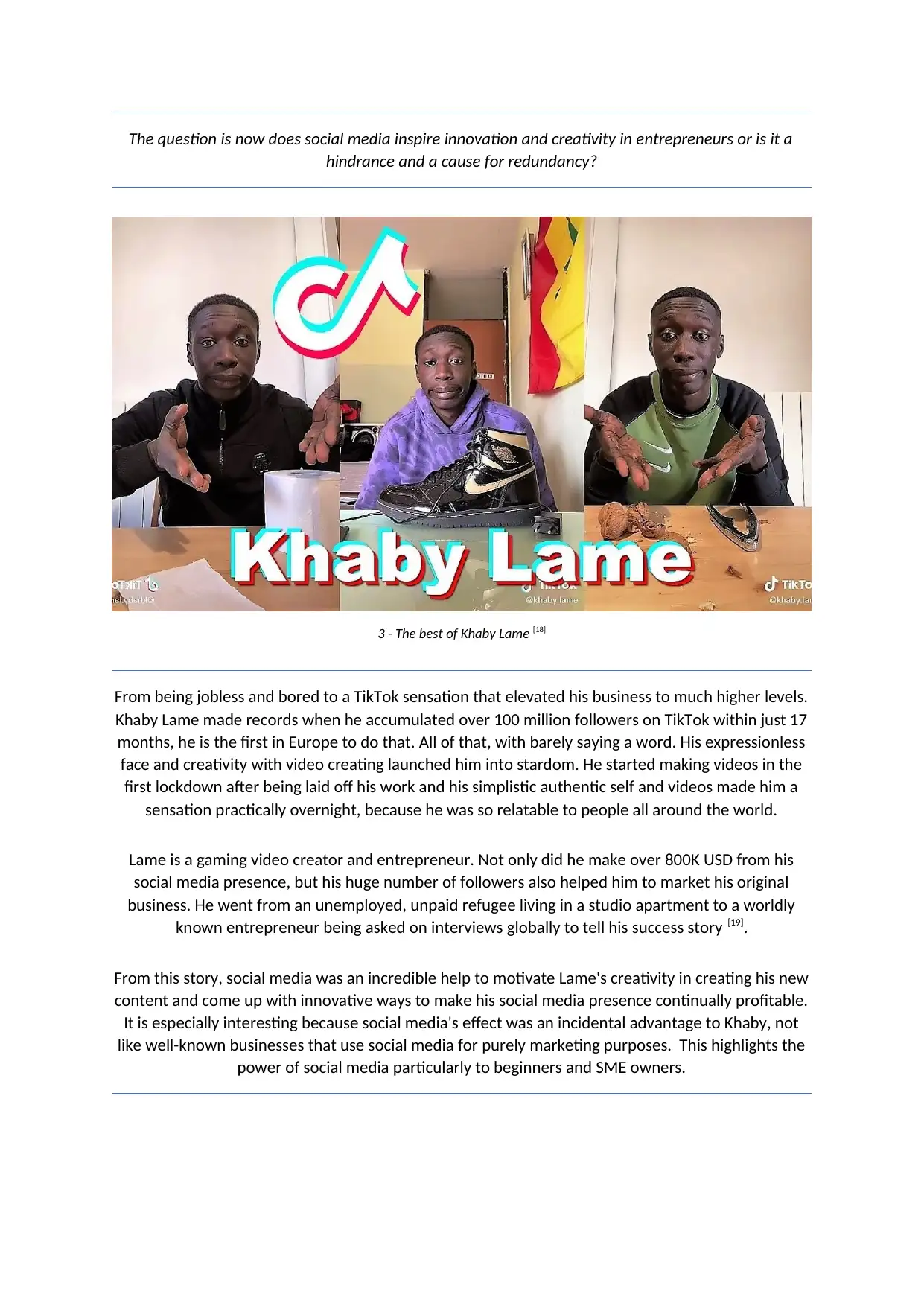
The question is now does social media inspire innovation and creativity in entrepreneurs or is it a
hindrance and a cause for redundancy?
3 - The best of Khaby Lame [18]
From being jobless and bored to a TikTok sensation that elevated his business to much higher levels.
Khaby Lame made records when he accumulated over 100 million followers on TikTok within just 17
months, he is the first in Europe to do that. All of that, with barely saying a word. His expressionless
face and creativity with video creating launched him into stardom. He started making videos in the
first lockdown after being laid off his work and his simplistic authentic self and videos made him a
sensation practically overnight, because he was so relatable to people all around the world.
Lame is a gaming video creator and entrepreneur. Not only did he make over 800K USD from his
social media presence, but his huge number of followers also helped him to market his original
business. He went from an unemployed, unpaid refugee living in a studio apartment to a worldly
known entrepreneur being asked on interviews globally to tell his success story [19].
From this story, social media was an incredible help to motivate Lame's creativity in creating his new
content and come up with innovative ways to make his social media presence continually profitable.
It is especially interesting because social media's effect was an incidental advantage to Khaby, not
like well-known businesses that use social media for purely marketing purposes. This highlights the
power of social media particularly to beginners and SME owners.
hindrance and a cause for redundancy?
3 - The best of Khaby Lame [18]
From being jobless and bored to a TikTok sensation that elevated his business to much higher levels.
Khaby Lame made records when he accumulated over 100 million followers on TikTok within just 17
months, he is the first in Europe to do that. All of that, with barely saying a word. His expressionless
face and creativity with video creating launched him into stardom. He started making videos in the
first lockdown after being laid off his work and his simplistic authentic self and videos made him a
sensation practically overnight, because he was so relatable to people all around the world.
Lame is a gaming video creator and entrepreneur. Not only did he make over 800K USD from his
social media presence, but his huge number of followers also helped him to market his original
business. He went from an unemployed, unpaid refugee living in a studio apartment to a worldly
known entrepreneur being asked on interviews globally to tell his success story [19].
From this story, social media was an incredible help to motivate Lame's creativity in creating his new
content and come up with innovative ways to make his social media presence continually profitable.
It is especially interesting because social media's effect was an incidental advantage to Khaby, not
like well-known businesses that use social media for purely marketing purposes. This highlights the
power of social media particularly to beginners and SME owners.
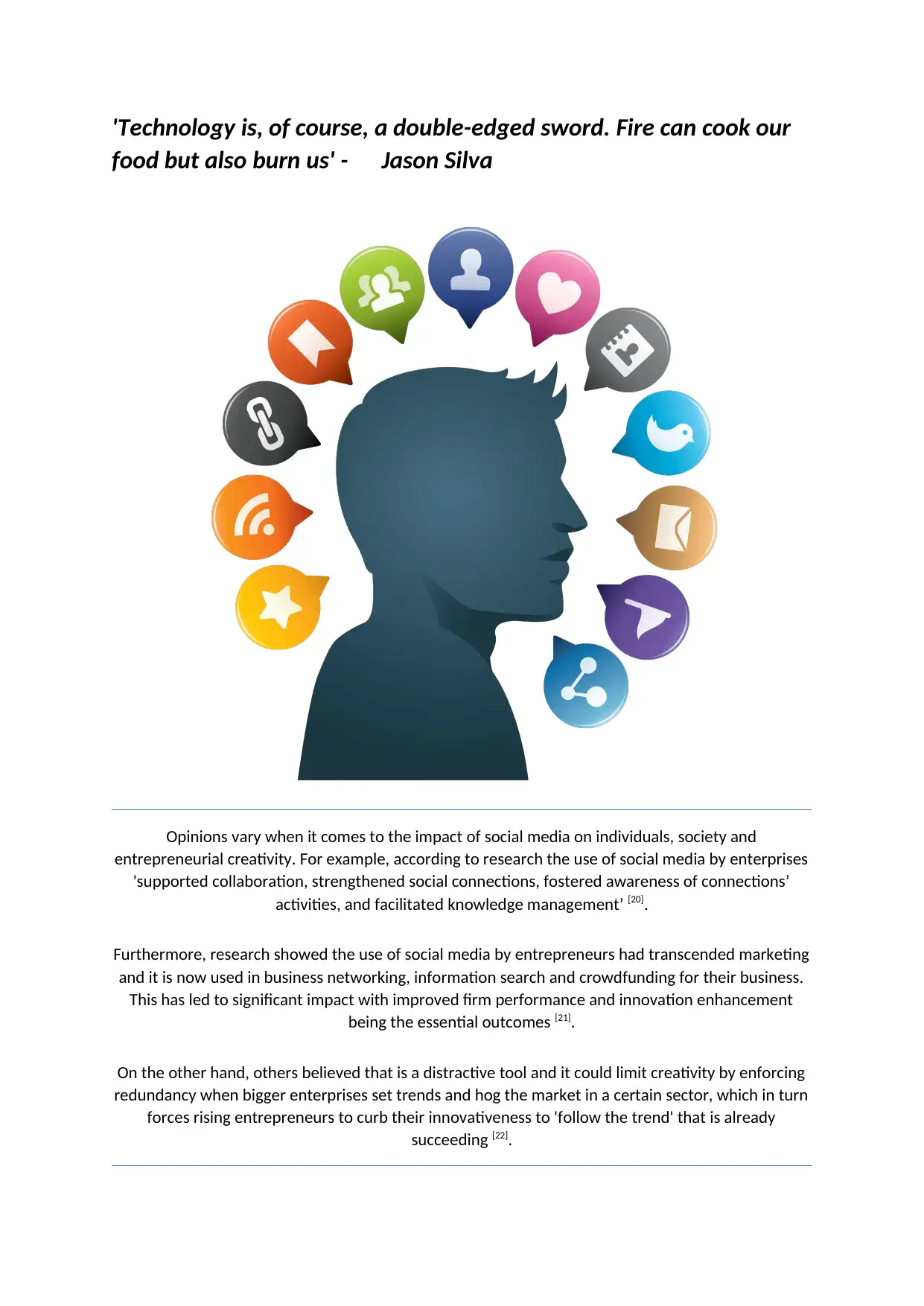
'Technology is, of course, a double-edged sword. Fire can cook our
food but also burn us' - Jason Silva
Opinions vary when it comes to the impact of social media on individuals, society and
entrepreneurial creativity. For example, according to research the use of social media by enterprises
'supported collaboration, strengthened social connections, fostered awareness of connections’
activities, and facilitated knowledge management’ [20].
Furthermore, research showed the use of social media by entrepreneurs had transcended marketing
and it is now used in business networking, information search and crowdfunding for their business.
This has led to significant impact with improved firm performance and innovation enhancement
being the essential outcomes [21].
On the other hand, others believed that is a distractive tool and it could limit creativity by enforcing
redundancy when bigger enterprises set trends and hog the market in a certain sector, which in turn
forces rising entrepreneurs to curb their innovativeness to 'follow the trend' that is already
succeeding [22].
food but also burn us' - Jason Silva
Opinions vary when it comes to the impact of social media on individuals, society and
entrepreneurial creativity. For example, according to research the use of social media by enterprises
'supported collaboration, strengthened social connections, fostered awareness of connections’
activities, and facilitated knowledge management’ [20].
Furthermore, research showed the use of social media by entrepreneurs had transcended marketing
and it is now used in business networking, information search and crowdfunding for their business.
This has led to significant impact with improved firm performance and innovation enhancement
being the essential outcomes [21].
On the other hand, others believed that is a distractive tool and it could limit creativity by enforcing
redundancy when bigger enterprises set trends and hog the market in a certain sector, which in turn
forces rising entrepreneurs to curb their innovativeness to 'follow the trend' that is already
succeeding [22].
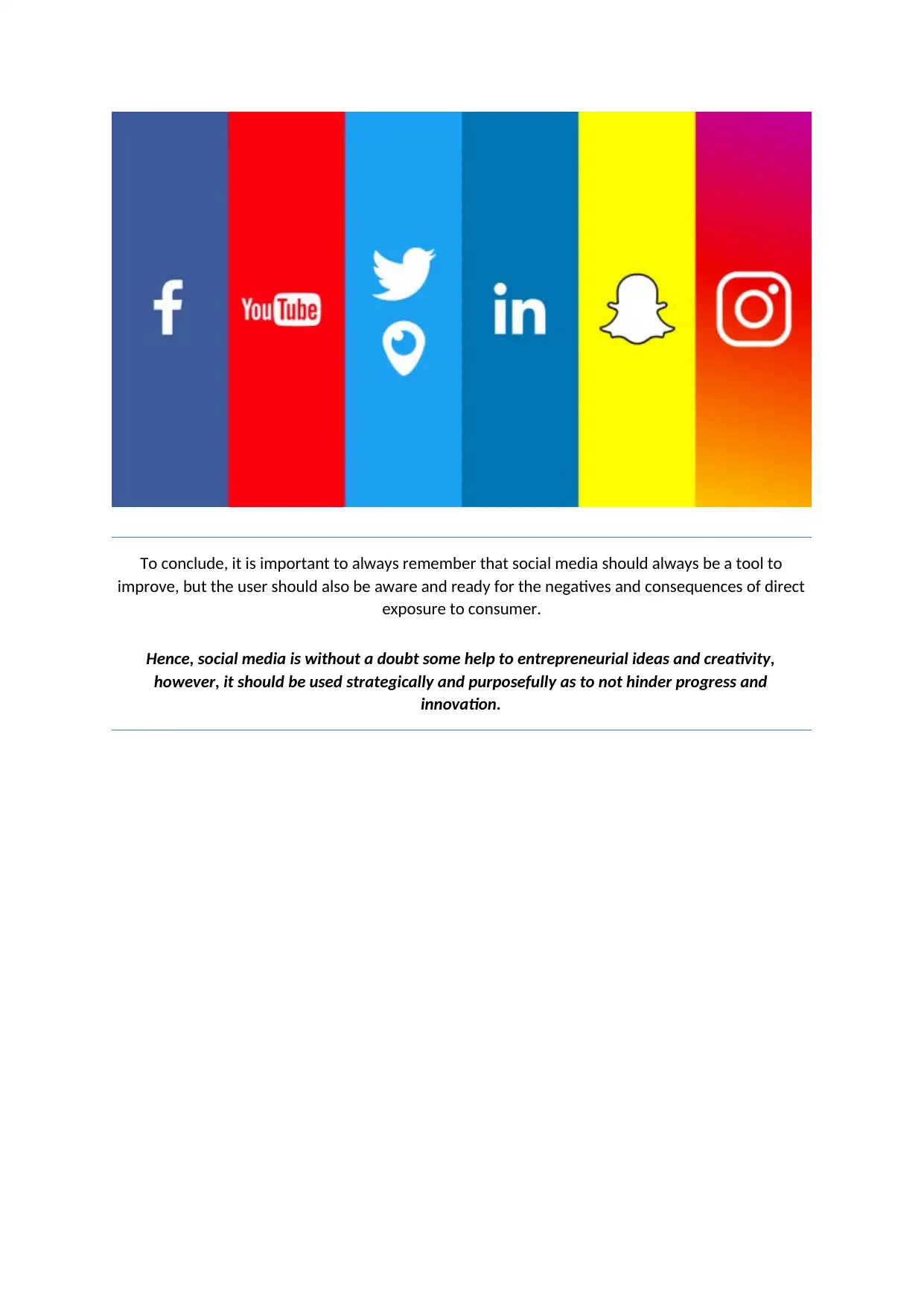
To conclude, it is important to always remember that social media should always be a tool to
improve, but the user should also be aware and ready for the negatives and consequences of direct
exposure to consumer.
Hence, social media is without a doubt some help to entrepreneurial ideas and creativity,
however, it should be used strategically and purposefully as to not hinder progress and
innovation.
improve, but the user should also be aware and ready for the negatives and consequences of direct
exposure to consumer.
Hence, social media is without a doubt some help to entrepreneurial ideas and creativity,
however, it should be used strategically and purposefully as to not hinder progress and
innovation.
Secure Best Marks with AI Grader
Need help grading? Try our AI Grader for instant feedback on your assignments.
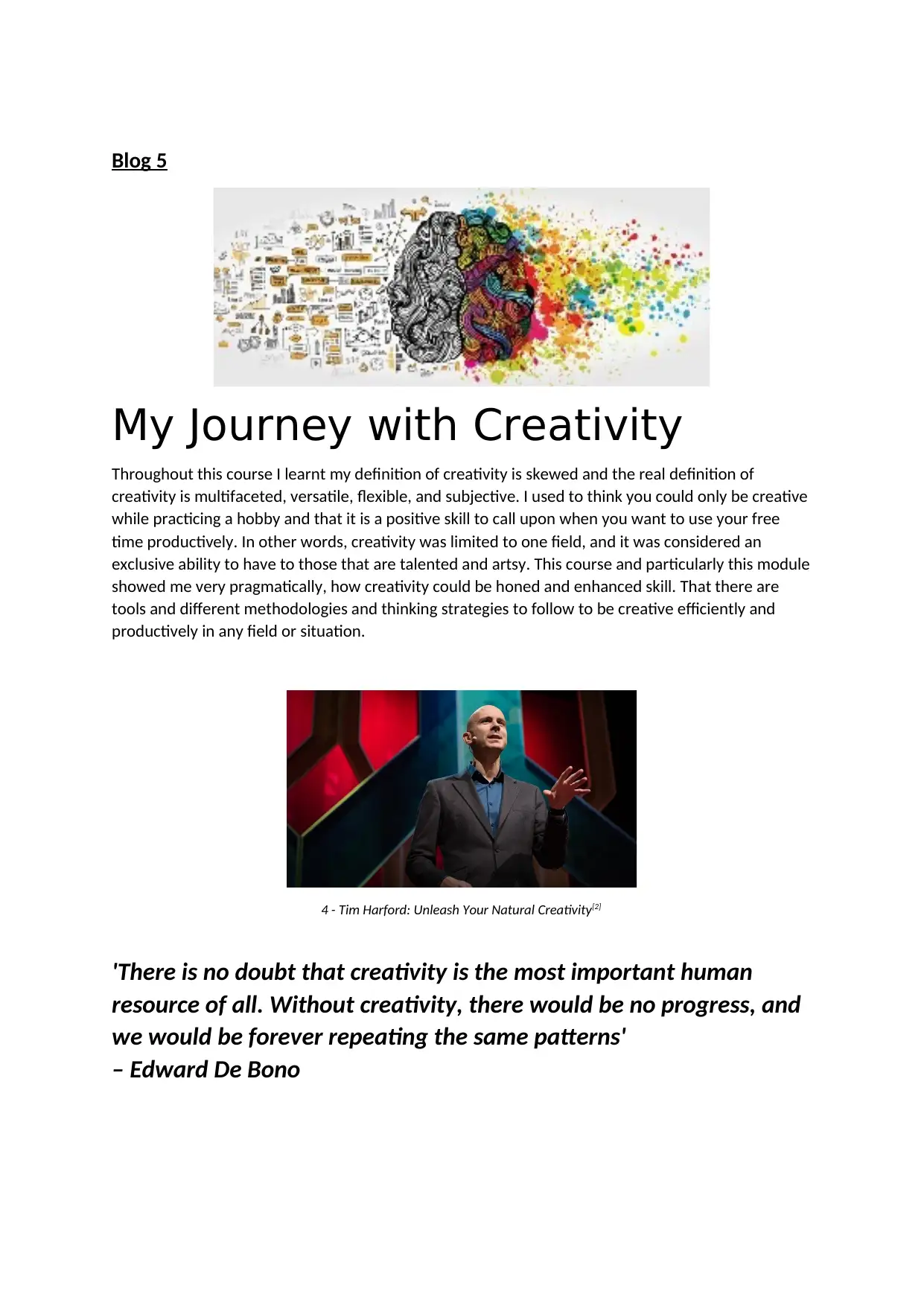
Blog 5
My Journey with Creativity
Throughout this course I learnt my definition of creativity is skewed and the real definition of
creativity is multifaceted, versatile, flexible, and subjective. I used to think you could only be creative
while practicing a hobby and that it is a positive skill to call upon when you want to use your free
time productively. In other words, creativity was limited to one field, and it was considered an
exclusive ability to have to those that are talented and artsy. This course and particularly this module
showed me very pragmatically, how creativity could be honed and enhanced skill. That there are
tools and different methodologies and thinking strategies to follow to be creative efficiently and
productively in any field or situation.
4 - Tim Harford: Unleash Your Natural Creativity[2]
'There is no doubt that creativity is the most important human
resource of all. Without creativity, there would be no progress, and
we would be forever repeating the same patterns'
– Edward De Bono
My Journey with Creativity
Throughout this course I learnt my definition of creativity is skewed and the real definition of
creativity is multifaceted, versatile, flexible, and subjective. I used to think you could only be creative
while practicing a hobby and that it is a positive skill to call upon when you want to use your free
time productively. In other words, creativity was limited to one field, and it was considered an
exclusive ability to have to those that are talented and artsy. This course and particularly this module
showed me very pragmatically, how creativity could be honed and enhanced skill. That there are
tools and different methodologies and thinking strategies to follow to be creative efficiently and
productively in any field or situation.
4 - Tim Harford: Unleash Your Natural Creativity[2]
'There is no doubt that creativity is the most important human
resource of all. Without creativity, there would be no progress, and
we would be forever repeating the same patterns'
– Edward De Bono
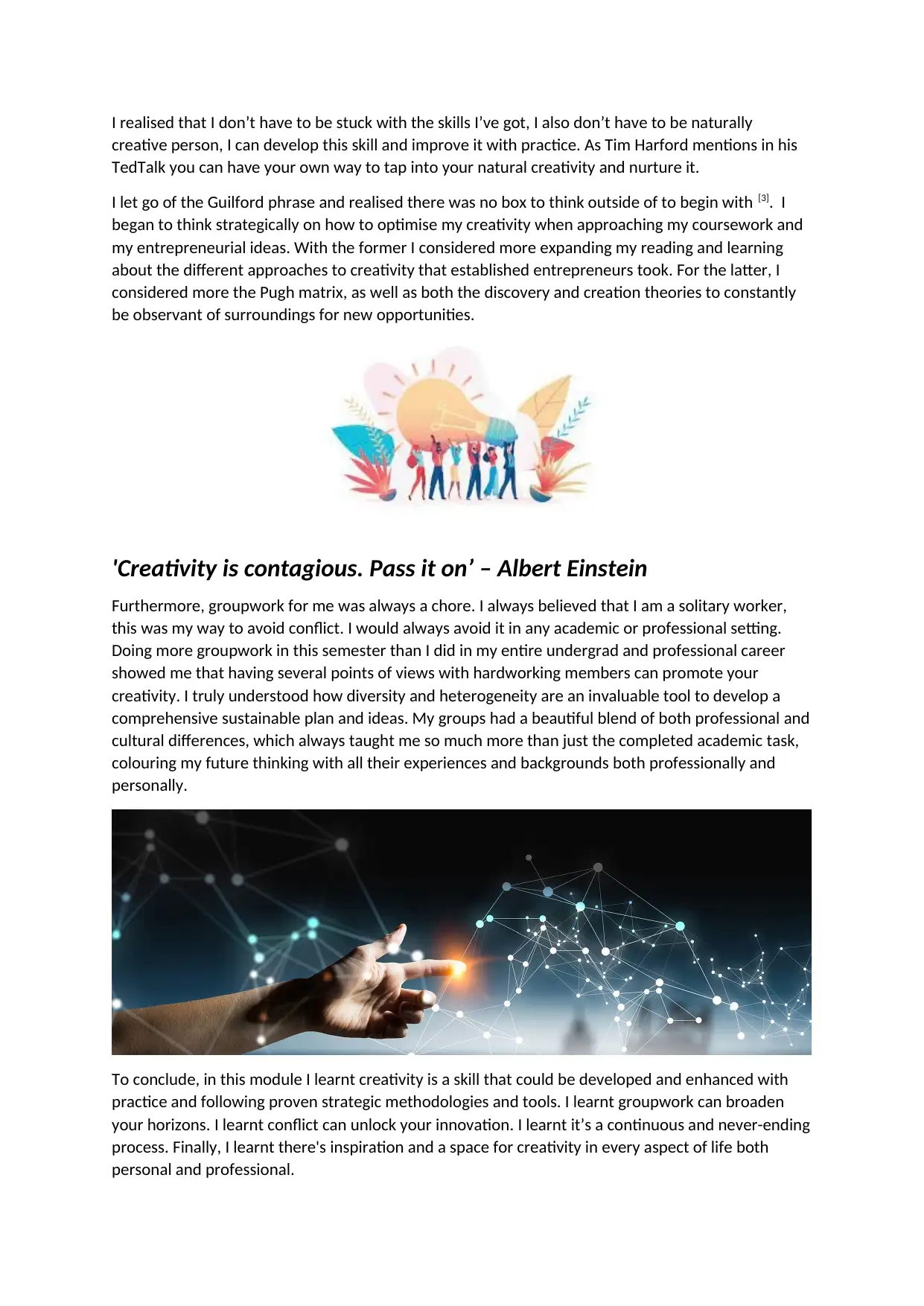
I realised that I don’t have to be stuck with the skills I’ve got, I also don’t have to be naturally
creative person, I can develop this skill and improve it with practice. As Tim Harford mentions in his
TedTalk you can have your own way to tap into your natural creativity and nurture it.
I let go of the Guilford phrase and realised there was no box to think outside of to begin with [3]. I
began to think strategically on how to optimise my creativity when approaching my coursework and
my entrepreneurial ideas. With the former I considered more expanding my reading and learning
about the different approaches to creativity that established entrepreneurs took. For the latter, I
considered more the Pugh matrix, as well as both the discovery and creation theories to constantly
be observant of surroundings for new opportunities.
'Creativity is contagious. Pass it on’ – Albert Einstein
Furthermore, groupwork for me was always a chore. I always believed that I am a solitary worker,
this was my way to avoid conflict. I would always avoid it in any academic or professional setting.
Doing more groupwork in this semester than I did in my entire undergrad and professional career
showed me that having several points of views with hardworking members can promote your
creativity. I truly understood how diversity and heterogeneity are an invaluable tool to develop a
comprehensive sustainable plan and ideas. My groups had a beautiful blend of both professional and
cultural differences, which always taught me so much more than just the completed academic task,
colouring my future thinking with all their experiences and backgrounds both professionally and
personally.
To conclude, in this module I learnt creativity is a skill that could be developed and enhanced with
practice and following proven strategic methodologies and tools. I learnt groupwork can broaden
your horizons. I learnt conflict can unlock your innovation. I learnt it’s a continuous and never-ending
process. Finally, I learnt there's inspiration and a space for creativity in every aspect of life both
personal and professional.
creative person, I can develop this skill and improve it with practice. As Tim Harford mentions in his
TedTalk you can have your own way to tap into your natural creativity and nurture it.
I let go of the Guilford phrase and realised there was no box to think outside of to begin with [3]. I
began to think strategically on how to optimise my creativity when approaching my coursework and
my entrepreneurial ideas. With the former I considered more expanding my reading and learning
about the different approaches to creativity that established entrepreneurs took. For the latter, I
considered more the Pugh matrix, as well as both the discovery and creation theories to constantly
be observant of surroundings for new opportunities.
'Creativity is contagious. Pass it on’ – Albert Einstein
Furthermore, groupwork for me was always a chore. I always believed that I am a solitary worker,
this was my way to avoid conflict. I would always avoid it in any academic or professional setting.
Doing more groupwork in this semester than I did in my entire undergrad and professional career
showed me that having several points of views with hardworking members can promote your
creativity. I truly understood how diversity and heterogeneity are an invaluable tool to develop a
comprehensive sustainable plan and ideas. My groups had a beautiful blend of both professional and
cultural differences, which always taught me so much more than just the completed academic task,
colouring my future thinking with all their experiences and backgrounds both professionally and
personally.
To conclude, in this module I learnt creativity is a skill that could be developed and enhanced with
practice and following proven strategic methodologies and tools. I learnt groupwork can broaden
your horizons. I learnt conflict can unlock your innovation. I learnt it’s a continuous and never-ending
process. Finally, I learnt there's inspiration and a space for creativity in every aspect of life both
personal and professional.
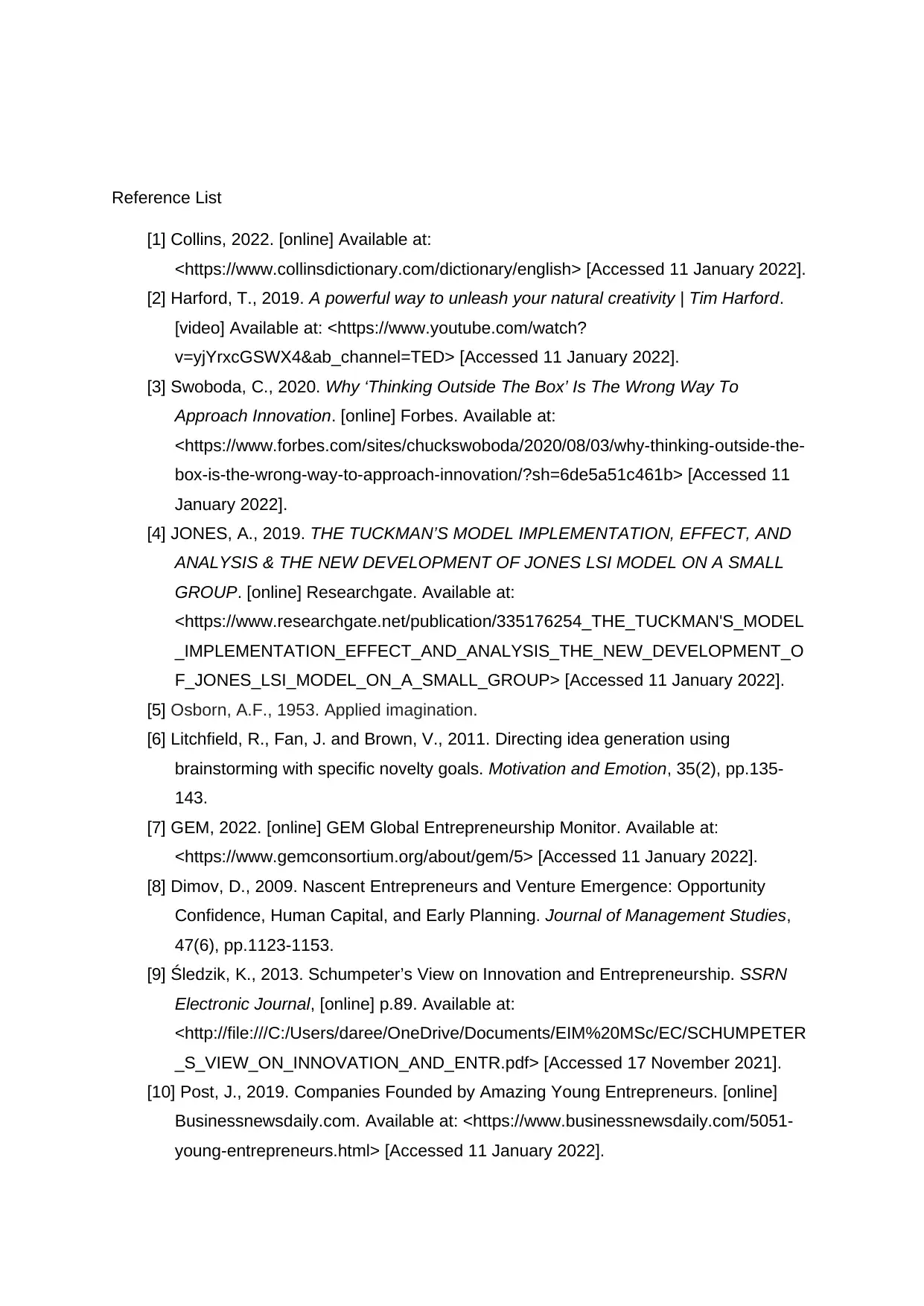
Reference List
[1] Collins, 2022. [online] Available at:
<https://www.collinsdictionary.com/dictionary/english> [Accessed 11 January 2022].
[2] Harford, T., 2019. A powerful way to unleash your natural creativity | Tim Harford.
[video] Available at: <https://www.youtube.com/watch?
v=yjYrxcGSWX4&ab_channel=TED> [Accessed 11 January 2022].
[3] Swoboda, C., 2020. Why ‘Thinking Outside The Box’ Is The Wrong Way To
Approach Innovation. [online] Forbes. Available at:
<https://www.forbes.com/sites/chuckswoboda/2020/08/03/why-thinking-outside-the-
box-is-the-wrong-way-to-approach-innovation/?sh=6de5a51c461b> [Accessed 11
January 2022].
[4] JONES, A., 2019. THE TUCKMAN’S MODEL IMPLEMENTATION, EFFECT, AND
ANALYSIS & THE NEW DEVELOPMENT OF JONES LSI MODEL ON A SMALL
GROUP. [online] Researchgate. Available at:
<https://www.researchgate.net/publication/335176254_THE_TUCKMAN'S_MODEL
_IMPLEMENTATION_EFFECT_AND_ANALYSIS_THE_NEW_DEVELOPMENT_O
F_JONES_LSI_MODEL_ON_A_SMALL_GROUP> [Accessed 11 January 2022].
[5] Osborn, A.F., 1953. Applied imagination.
[6] Litchfield, R., Fan, J. and Brown, V., 2011. Directing idea generation using
brainstorming with specific novelty goals. Motivation and Emotion, 35(2), pp.135-
143.
[7] GEM, 2022. [online] GEM Global Entrepreneurship Monitor. Available at:
<https://www.gemconsortium.org/about/gem/5> [Accessed 11 January 2022].
[8] Dimov, D., 2009. Nascent Entrepreneurs and Venture Emergence: Opportunity
Confidence, Human Capital, and Early Planning. Journal of Management Studies,
47(6), pp.1123-1153.
[9] Śledzik, K., 2013. Schumpeter’s View on Innovation and Entrepreneurship. SSRN
Electronic Journal, [online] p.89. Available at:
<http://file:///C:/Users/daree/OneDrive/Documents/EIM%20MSc/EC/SCHUMPETER
_S_VIEW_ON_INNOVATION_AND_ENTR.pdf> [Accessed 17 November 2021].
[10] Post, J., 2019. Companies Founded by Amazing Young Entrepreneurs. [online]
Businessnewsdaily.com. Available at: <https://www.businessnewsdaily.com/5051-
young-entrepreneurs.html> [Accessed 11 January 2022].
[1] Collins, 2022. [online] Available at:
<https://www.collinsdictionary.com/dictionary/english> [Accessed 11 January 2022].
[2] Harford, T., 2019. A powerful way to unleash your natural creativity | Tim Harford.
[video] Available at: <https://www.youtube.com/watch?
v=yjYrxcGSWX4&ab_channel=TED> [Accessed 11 January 2022].
[3] Swoboda, C., 2020. Why ‘Thinking Outside The Box’ Is The Wrong Way To
Approach Innovation. [online] Forbes. Available at:
<https://www.forbes.com/sites/chuckswoboda/2020/08/03/why-thinking-outside-the-
box-is-the-wrong-way-to-approach-innovation/?sh=6de5a51c461b> [Accessed 11
January 2022].
[4] JONES, A., 2019. THE TUCKMAN’S MODEL IMPLEMENTATION, EFFECT, AND
ANALYSIS & THE NEW DEVELOPMENT OF JONES LSI MODEL ON A SMALL
GROUP. [online] Researchgate. Available at:
<https://www.researchgate.net/publication/335176254_THE_TUCKMAN'S_MODEL
_IMPLEMENTATION_EFFECT_AND_ANALYSIS_THE_NEW_DEVELOPMENT_O
F_JONES_LSI_MODEL_ON_A_SMALL_GROUP> [Accessed 11 January 2022].
[5] Osborn, A.F., 1953. Applied imagination.
[6] Litchfield, R., Fan, J. and Brown, V., 2011. Directing idea generation using
brainstorming with specific novelty goals. Motivation and Emotion, 35(2), pp.135-
143.
[7] GEM, 2022. [online] GEM Global Entrepreneurship Monitor. Available at:
<https://www.gemconsortium.org/about/gem/5> [Accessed 11 January 2022].
[8] Dimov, D., 2009. Nascent Entrepreneurs and Venture Emergence: Opportunity
Confidence, Human Capital, and Early Planning. Journal of Management Studies,
47(6), pp.1123-1153.
[9] Śledzik, K., 2013. Schumpeter’s View on Innovation and Entrepreneurship. SSRN
Electronic Journal, [online] p.89. Available at:
<http://file:///C:/Users/daree/OneDrive/Documents/EIM%20MSc/EC/SCHUMPETER
_S_VIEW_ON_INNOVATION_AND_ENTR.pdf> [Accessed 17 November 2021].
[10] Post, J., 2019. Companies Founded by Amazing Young Entrepreneurs. [online]
Businessnewsdaily.com. Available at: <https://www.businessnewsdaily.com/5051-
young-entrepreneurs.html> [Accessed 11 January 2022].
Paraphrase This Document
Need a fresh take? Get an instant paraphrase of this document with our AI Paraphraser
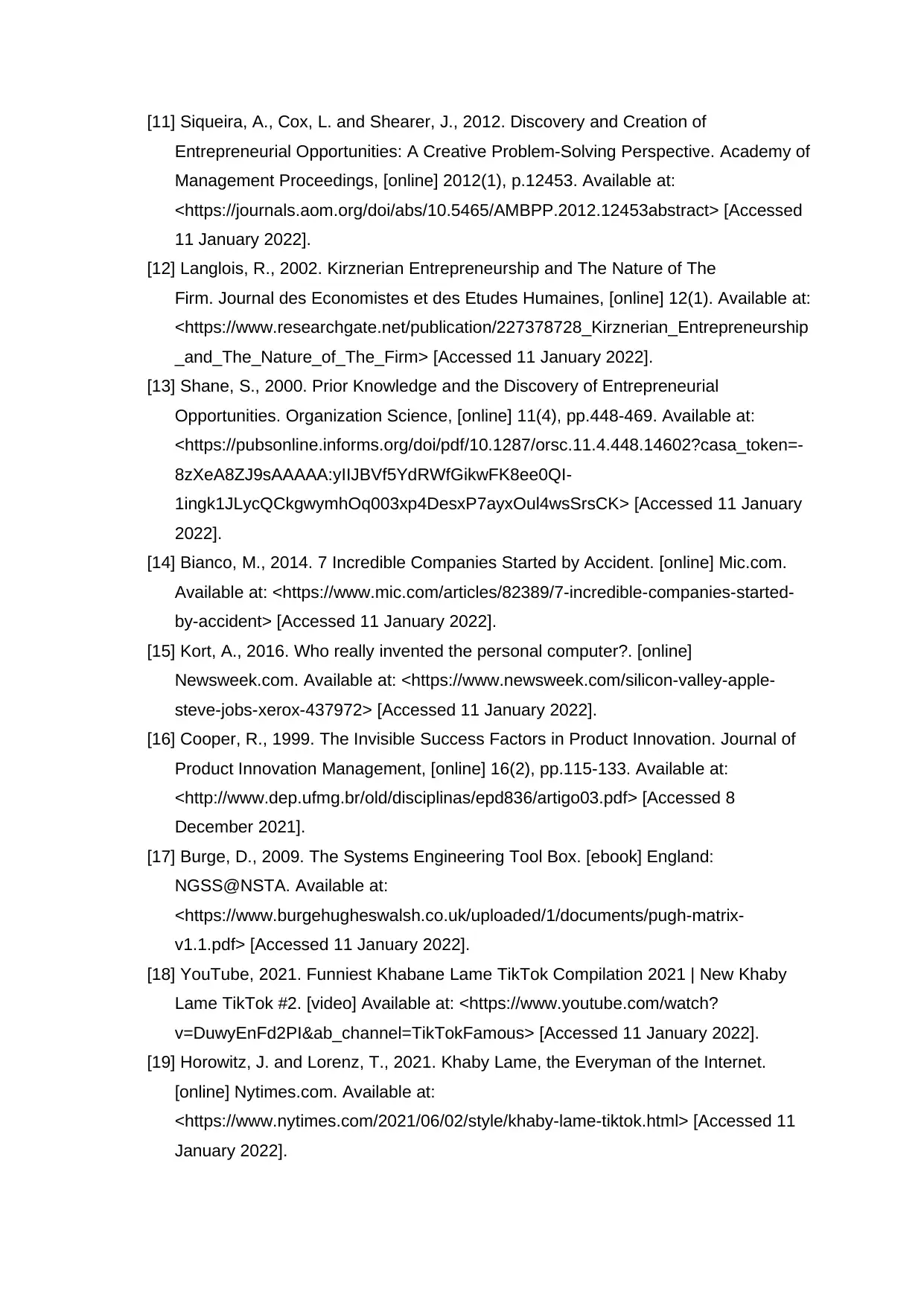
[11] Siqueira, A., Cox, L. and Shearer, J., 2012. Discovery and Creation of
Entrepreneurial Opportunities: A Creative Problem-Solving Perspective. Academy of
Management Proceedings, [online] 2012(1), p.12453. Available at:
<https://journals.aom.org/doi/abs/10.5465/AMBPP.2012.12453abstract> [Accessed
11 January 2022].
[12] Langlois, R., 2002. Kirznerian Entrepreneurship and The Nature of The
Firm. Journal des Economistes et des Etudes Humaines, [online] 12(1). Available at:
<https://www.researchgate.net/publication/227378728_Kirznerian_Entrepreneurship
_and_The_Nature_of_The_Firm> [Accessed 11 January 2022].
[13] Shane, S., 2000. Prior Knowledge and the Discovery of Entrepreneurial
Opportunities. Organization Science, [online] 11(4), pp.448-469. Available at:
<https://pubsonline.informs.org/doi/pdf/10.1287/orsc.11.4.448.14602?casa_token=-
8zXeA8ZJ9sAAAAA:yIIJBVf5YdRWfGikwFK8ee0QI-
1ingk1JLycQCkgwymhOq003xp4DesxP7ayxOul4wsSrsCK> [Accessed 11 January
2022].
[14] Bianco, M., 2014. 7 Incredible Companies Started by Accident. [online] Mic.com.
Available at: <https://www.mic.com/articles/82389/7-incredible-companies-started-
by-accident> [Accessed 11 January 2022].
[15] Kort, A., 2016. Who really invented the personal computer?. [online]
Newsweek.com. Available at: <https://www.newsweek.com/silicon-valley-apple-
steve-jobs-xerox-437972> [Accessed 11 January 2022].
[16] Cooper, R., 1999. The Invisible Success Factors in Product Innovation. Journal of
Product Innovation Management, [online] 16(2), pp.115-133. Available at:
<http://www.dep.ufmg.br/old/disciplinas/epd836/artigo03.pdf> [Accessed 8
December 2021].
[17] Burge, D., 2009. The Systems Engineering Tool Box. [ebook] England:
NGSS@NSTA. Available at:
<https://www.burgehugheswalsh.co.uk/uploaded/1/documents/pugh-matrix-
v1.1.pdf> [Accessed 11 January 2022].
[18] YouTube, 2021. Funniest Khabane Lame TikTok Compilation 2021 | New Khaby
Lame TikTok #2. [video] Available at: <https://www.youtube.com/watch?
v=DuwyEnFd2PI&ab_channel=TikTokFamous> [Accessed 11 January 2022].
[19] Horowitz, J. and Lorenz, T., 2021. Khaby Lame, the Everyman of the Internet.
[online] Nytimes.com. Available at:
<https://www.nytimes.com/2021/06/02/style/khaby-lame-tiktok.html> [Accessed 11
January 2022].
Entrepreneurial Opportunities: A Creative Problem-Solving Perspective. Academy of
Management Proceedings, [online] 2012(1), p.12453. Available at:
<https://journals.aom.org/doi/abs/10.5465/AMBPP.2012.12453abstract> [Accessed
11 January 2022].
[12] Langlois, R., 2002. Kirznerian Entrepreneurship and The Nature of The
Firm. Journal des Economistes et des Etudes Humaines, [online] 12(1). Available at:
<https://www.researchgate.net/publication/227378728_Kirznerian_Entrepreneurship
_and_The_Nature_of_The_Firm> [Accessed 11 January 2022].
[13] Shane, S., 2000. Prior Knowledge and the Discovery of Entrepreneurial
Opportunities. Organization Science, [online] 11(4), pp.448-469. Available at:
<https://pubsonline.informs.org/doi/pdf/10.1287/orsc.11.4.448.14602?casa_token=-
8zXeA8ZJ9sAAAAA:yIIJBVf5YdRWfGikwFK8ee0QI-
1ingk1JLycQCkgwymhOq003xp4DesxP7ayxOul4wsSrsCK> [Accessed 11 January
2022].
[14] Bianco, M., 2014. 7 Incredible Companies Started by Accident. [online] Mic.com.
Available at: <https://www.mic.com/articles/82389/7-incredible-companies-started-
by-accident> [Accessed 11 January 2022].
[15] Kort, A., 2016. Who really invented the personal computer?. [online]
Newsweek.com. Available at: <https://www.newsweek.com/silicon-valley-apple-
steve-jobs-xerox-437972> [Accessed 11 January 2022].
[16] Cooper, R., 1999. The Invisible Success Factors in Product Innovation. Journal of
Product Innovation Management, [online] 16(2), pp.115-133. Available at:
<http://www.dep.ufmg.br/old/disciplinas/epd836/artigo03.pdf> [Accessed 8
December 2021].
[17] Burge, D., 2009. The Systems Engineering Tool Box. [ebook] England:
NGSS@NSTA. Available at:
<https://www.burgehugheswalsh.co.uk/uploaded/1/documents/pugh-matrix-
v1.1.pdf> [Accessed 11 January 2022].
[18] YouTube, 2021. Funniest Khabane Lame TikTok Compilation 2021 | New Khaby
Lame TikTok #2. [video] Available at: <https://www.youtube.com/watch?
v=DuwyEnFd2PI&ab_channel=TikTokFamous> [Accessed 11 January 2022].
[19] Horowitz, J. and Lorenz, T., 2021. Khaby Lame, the Everyman of the Internet.
[online] Nytimes.com. Available at:
<https://www.nytimes.com/2021/06/02/style/khaby-lame-tiktok.html> [Accessed 11
January 2022].
1 out of 20
Related Documents
Your All-in-One AI-Powered Toolkit for Academic Success.
+13062052269
info@desklib.com
Available 24*7 on WhatsApp / Email
![[object Object]](/_next/static/media/star-bottom.7253800d.svg)
Unlock your academic potential
© 2024 | Zucol Services PVT LTD | All rights reserved.
